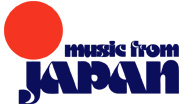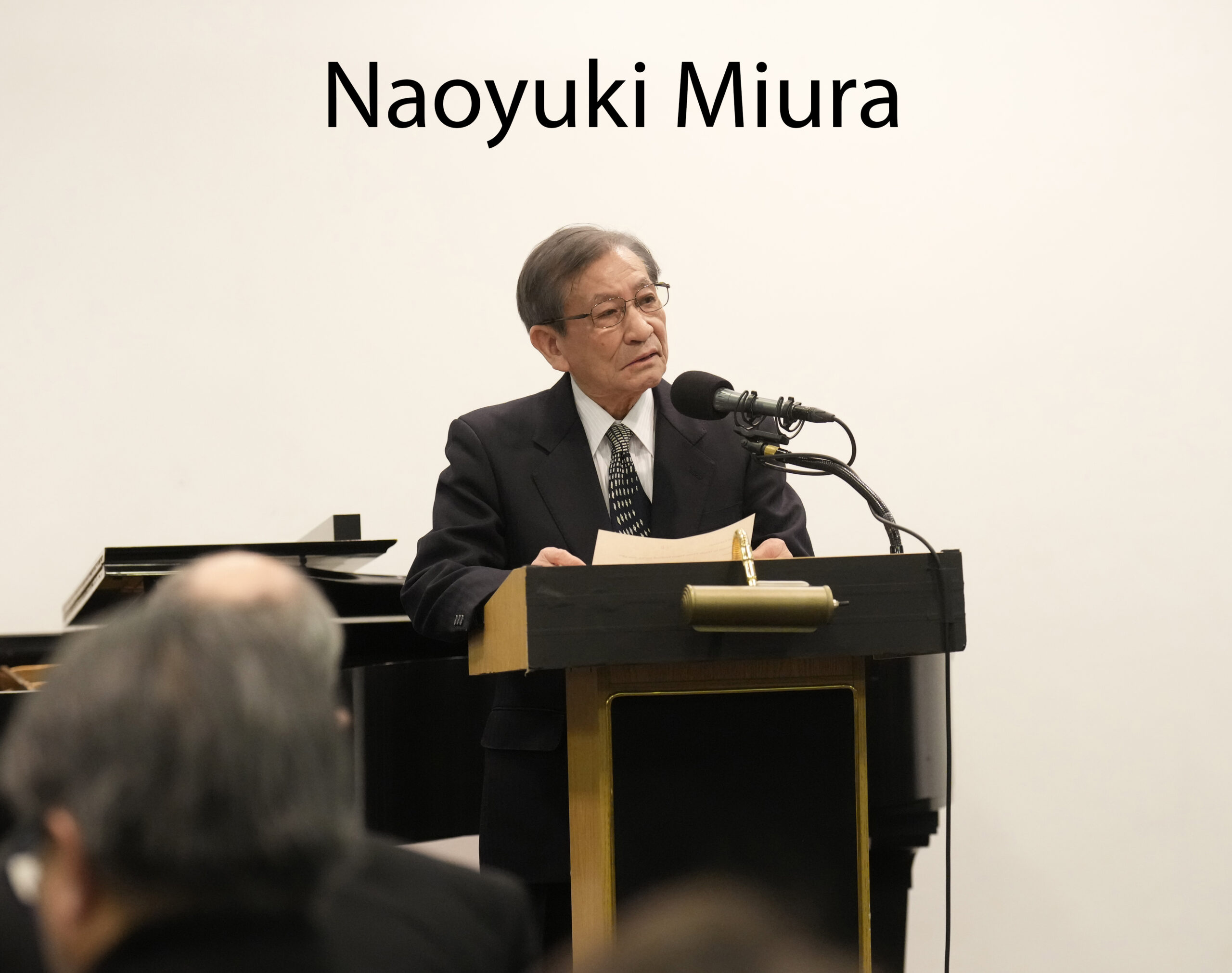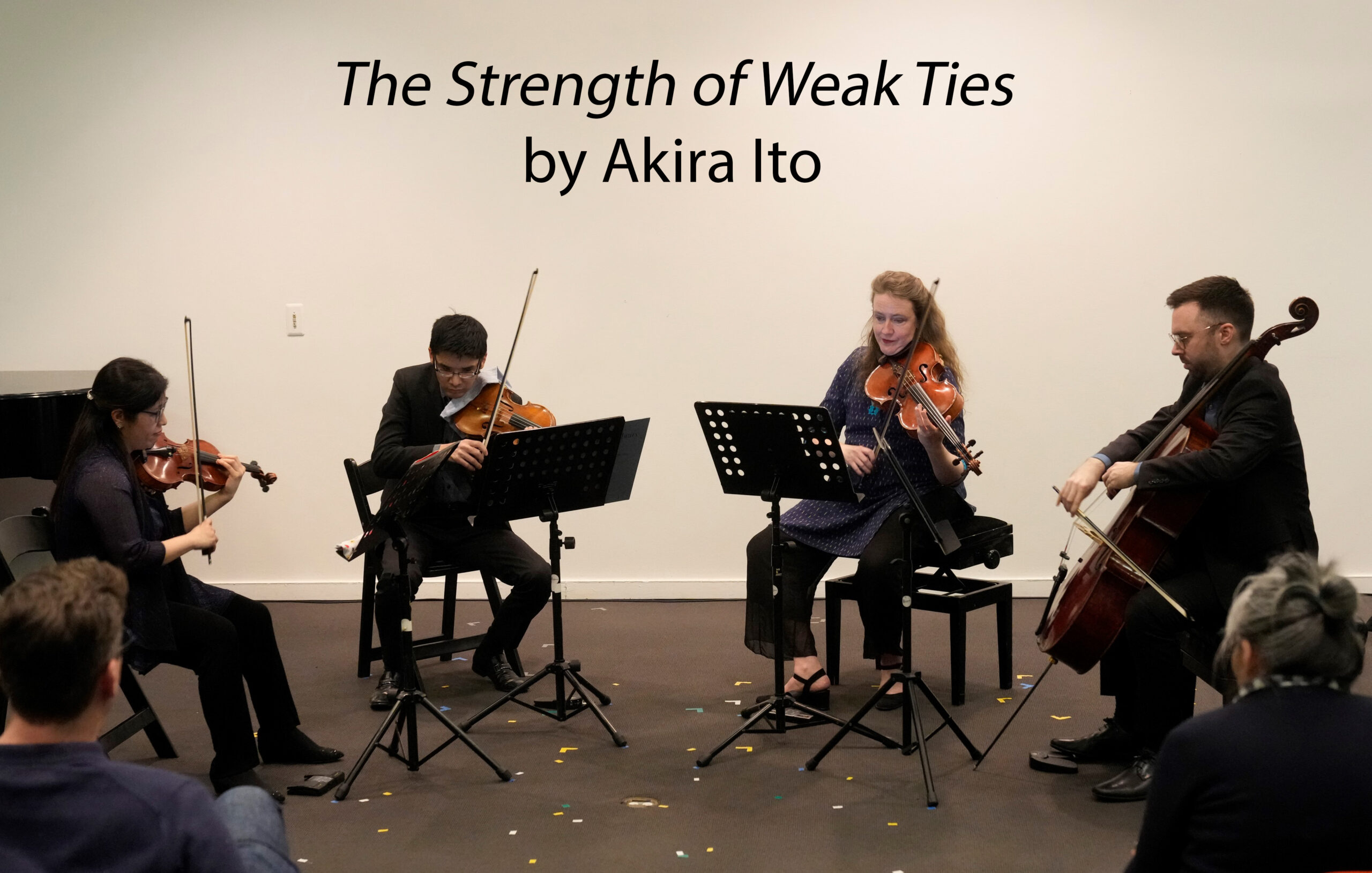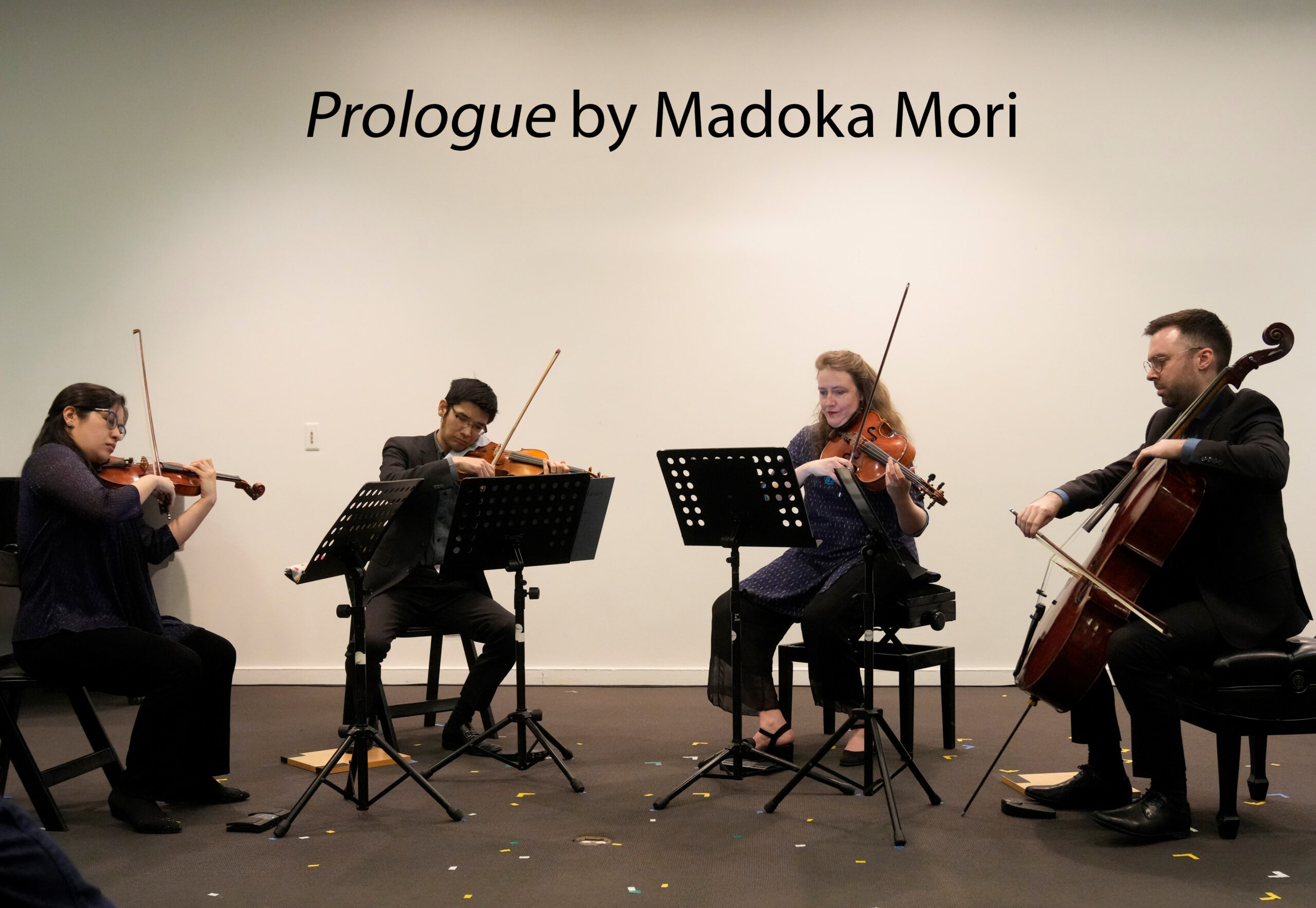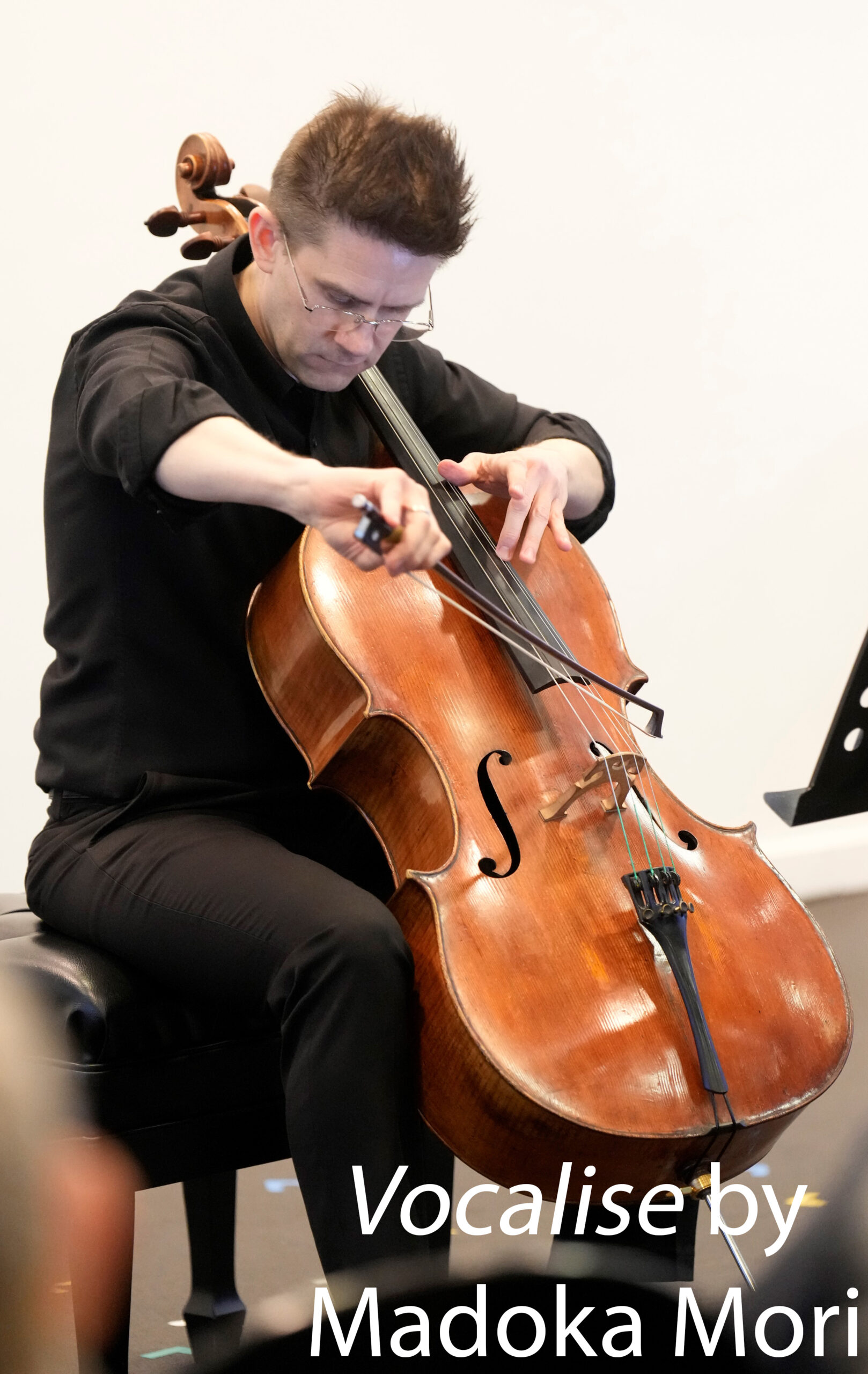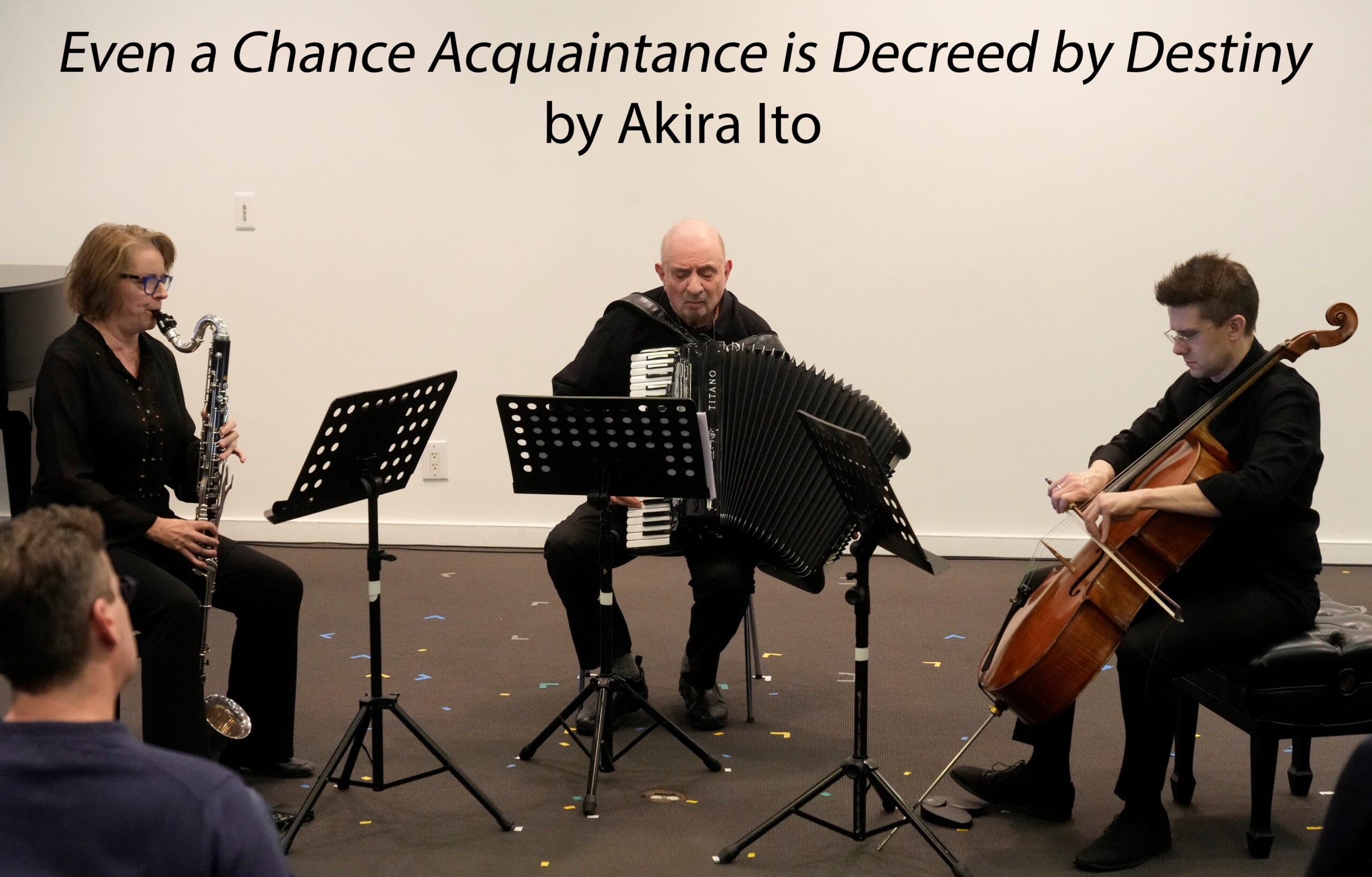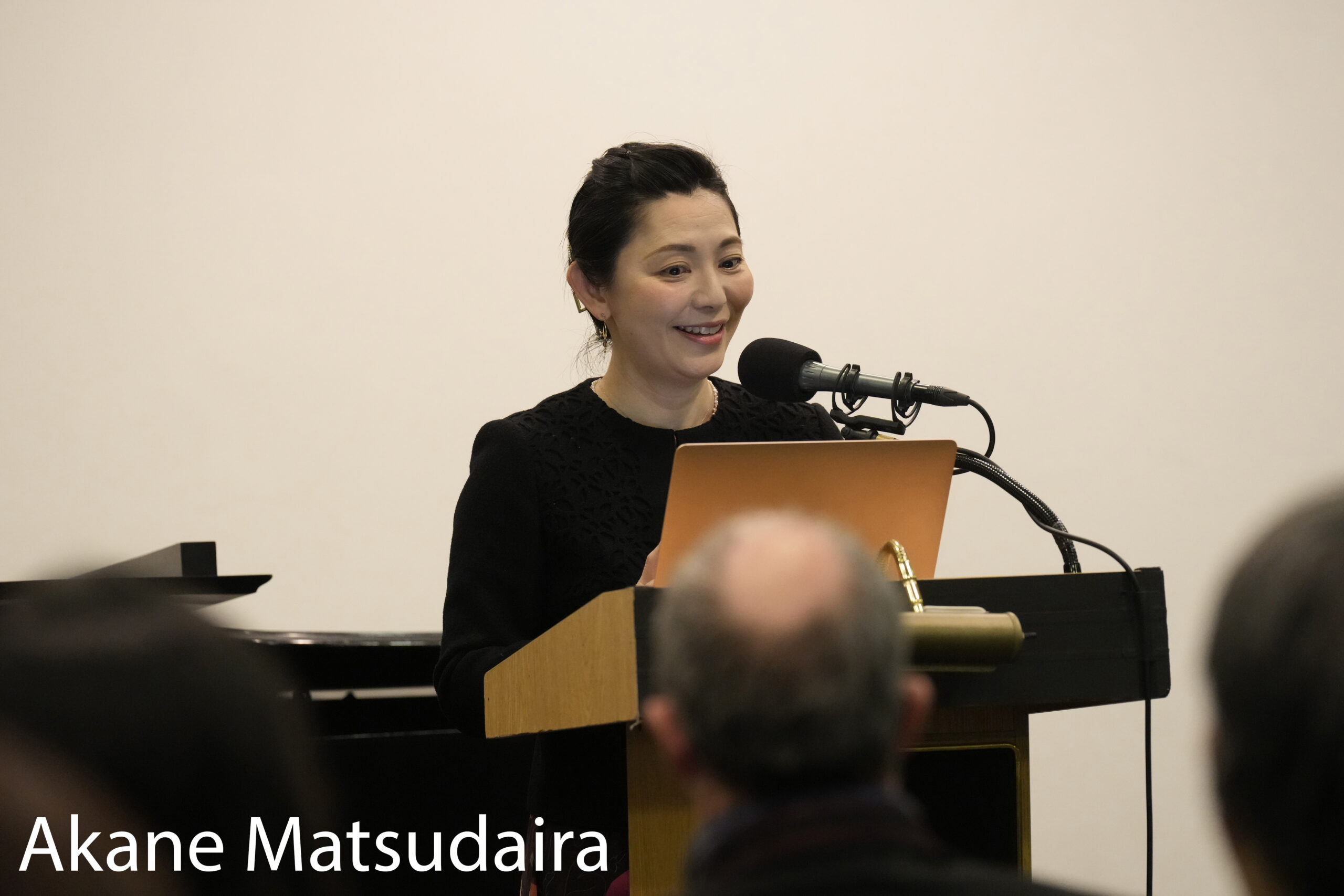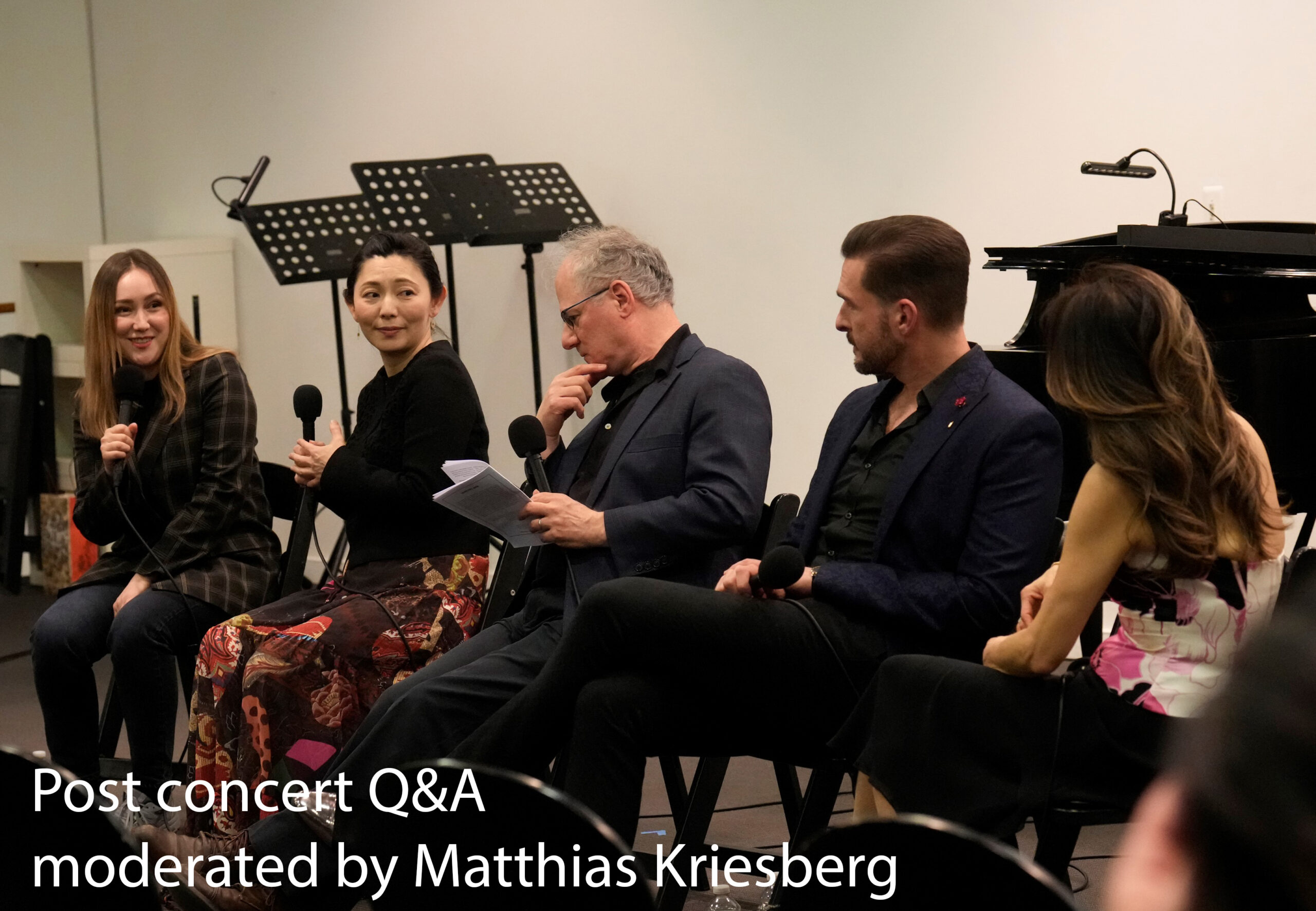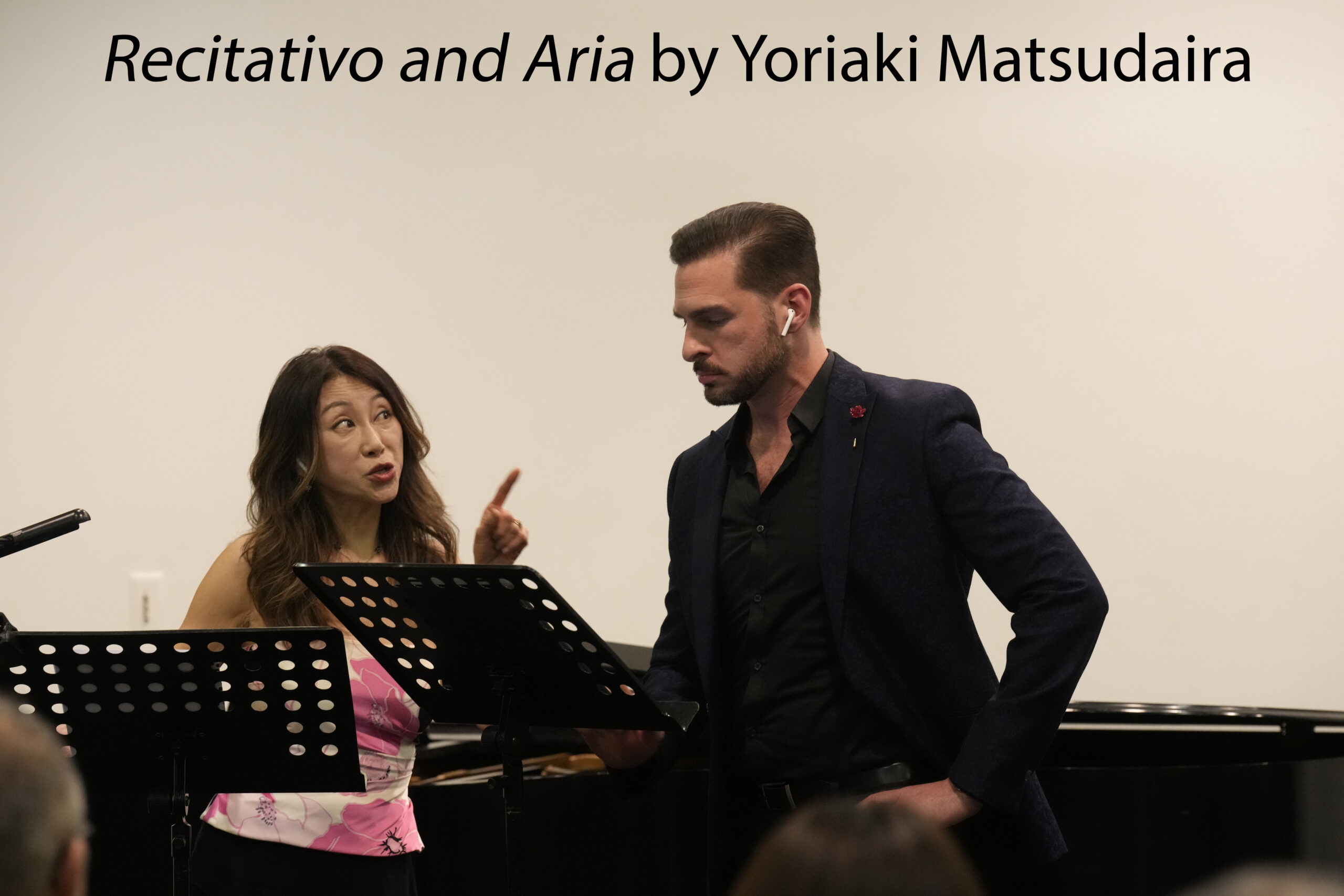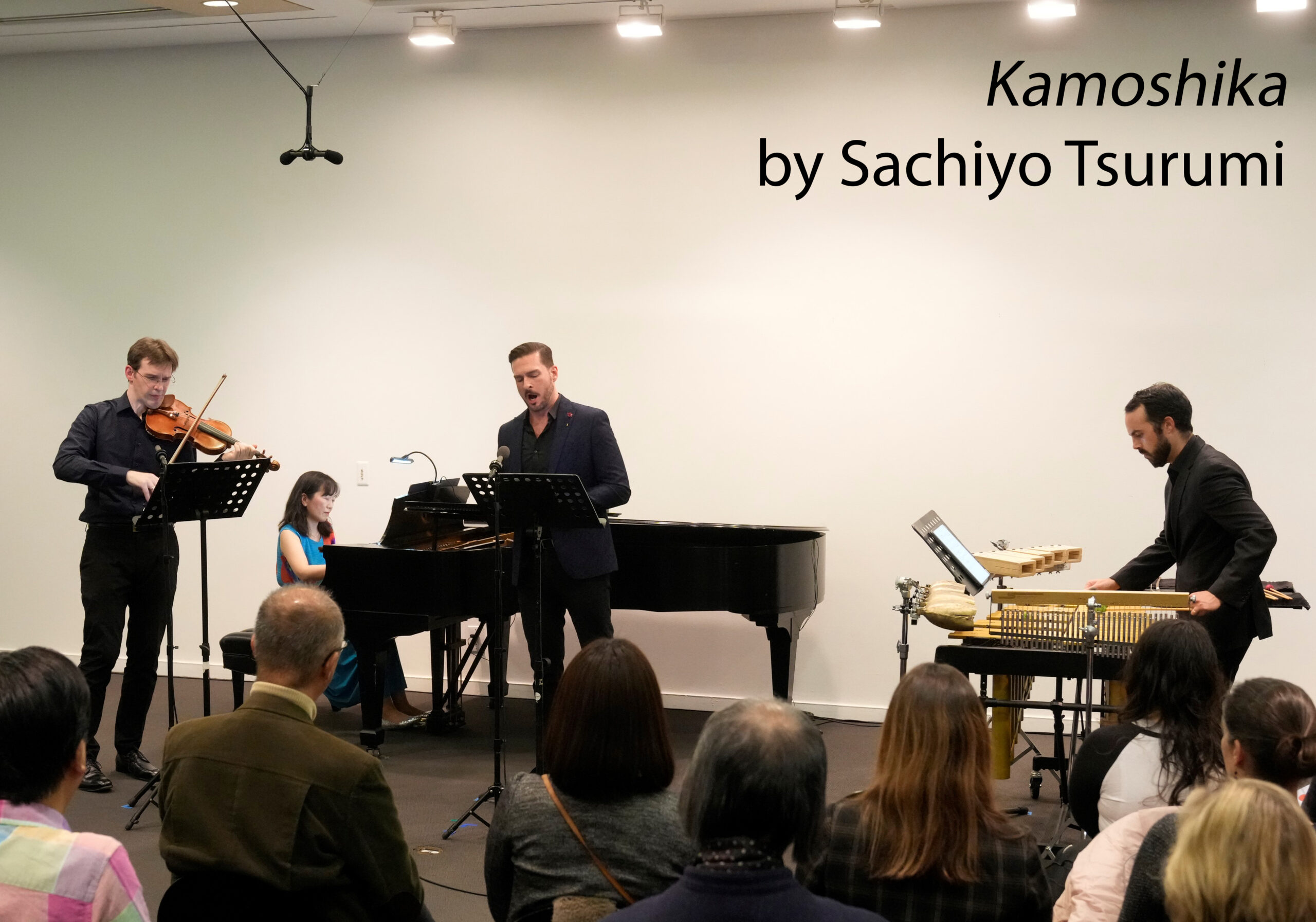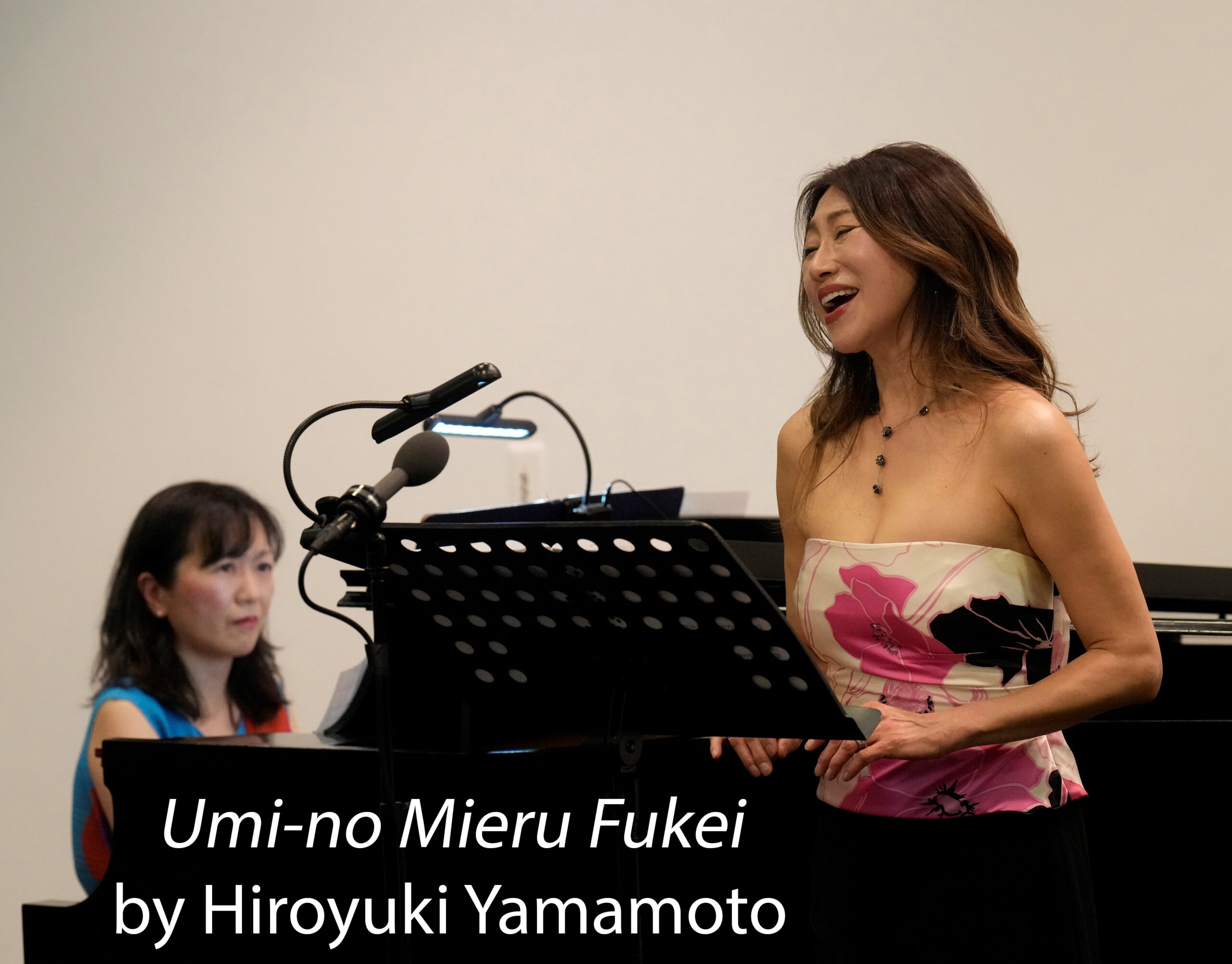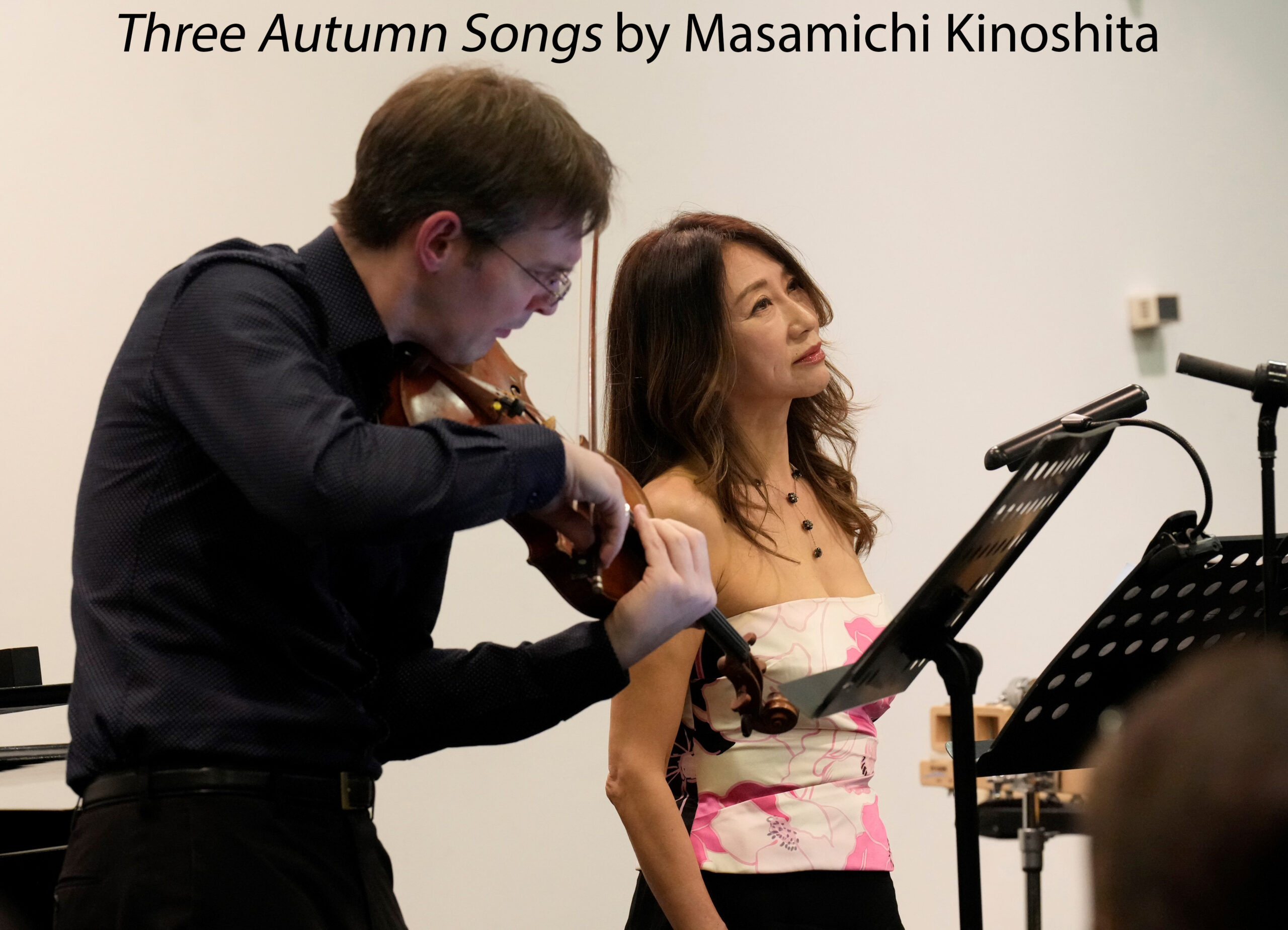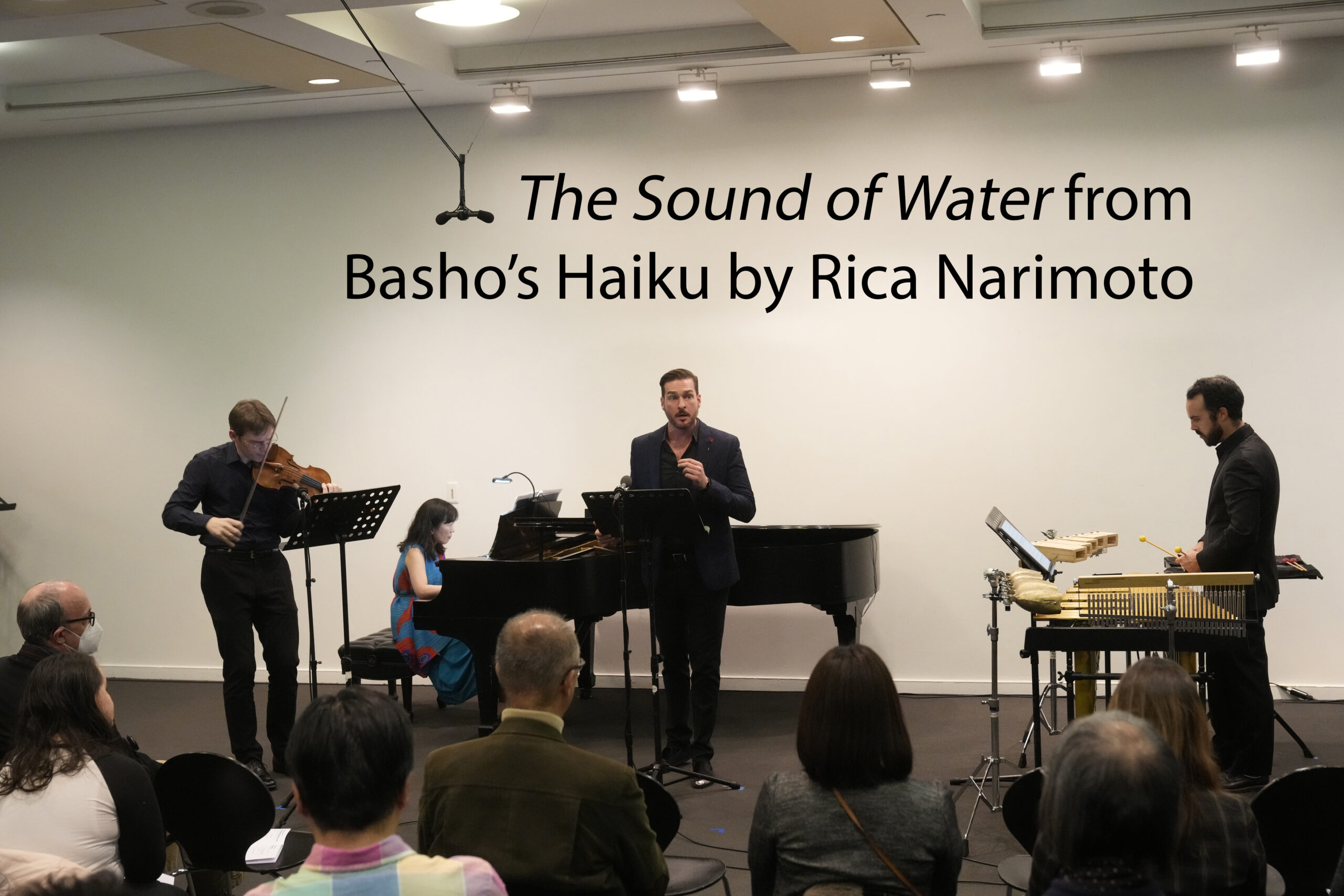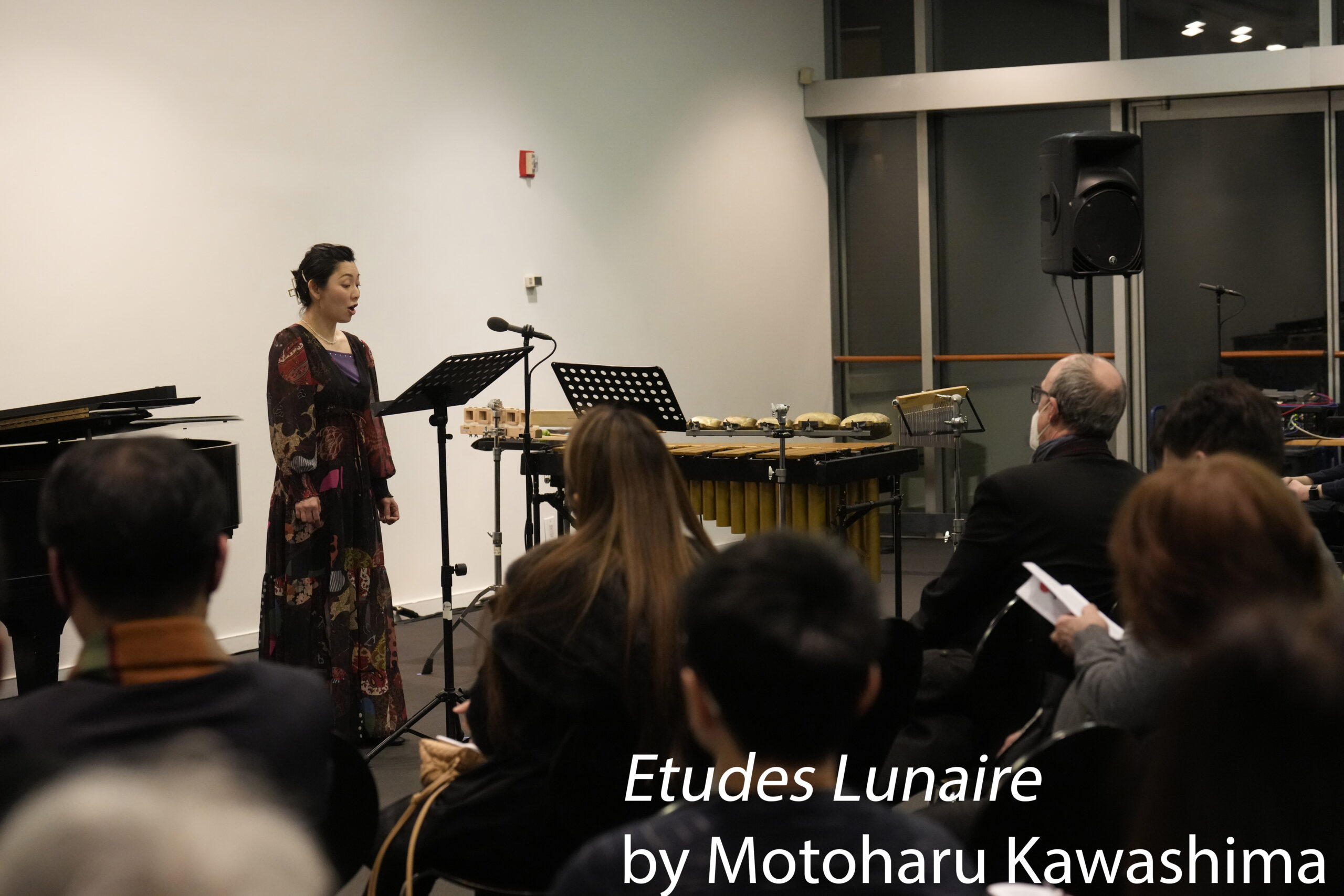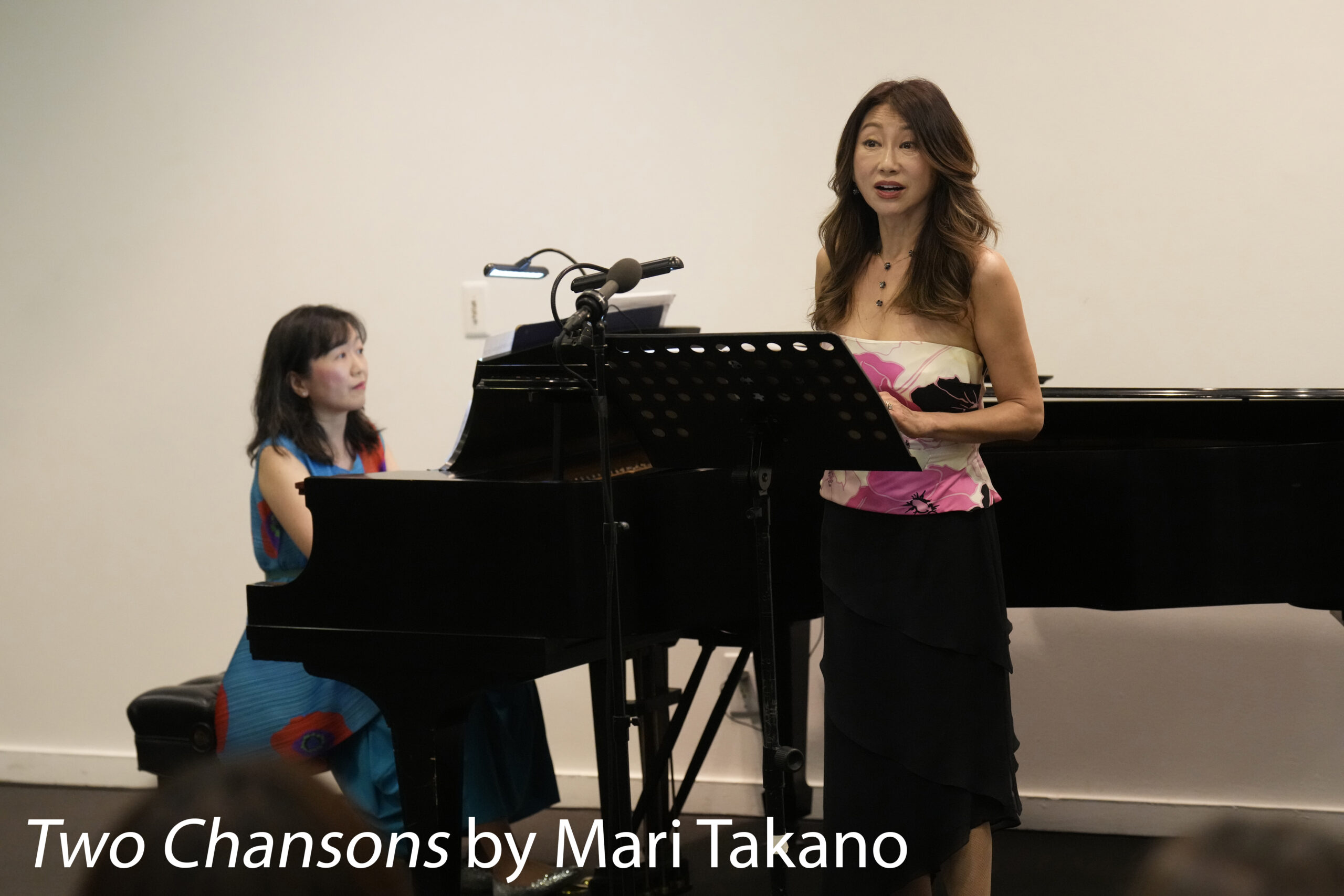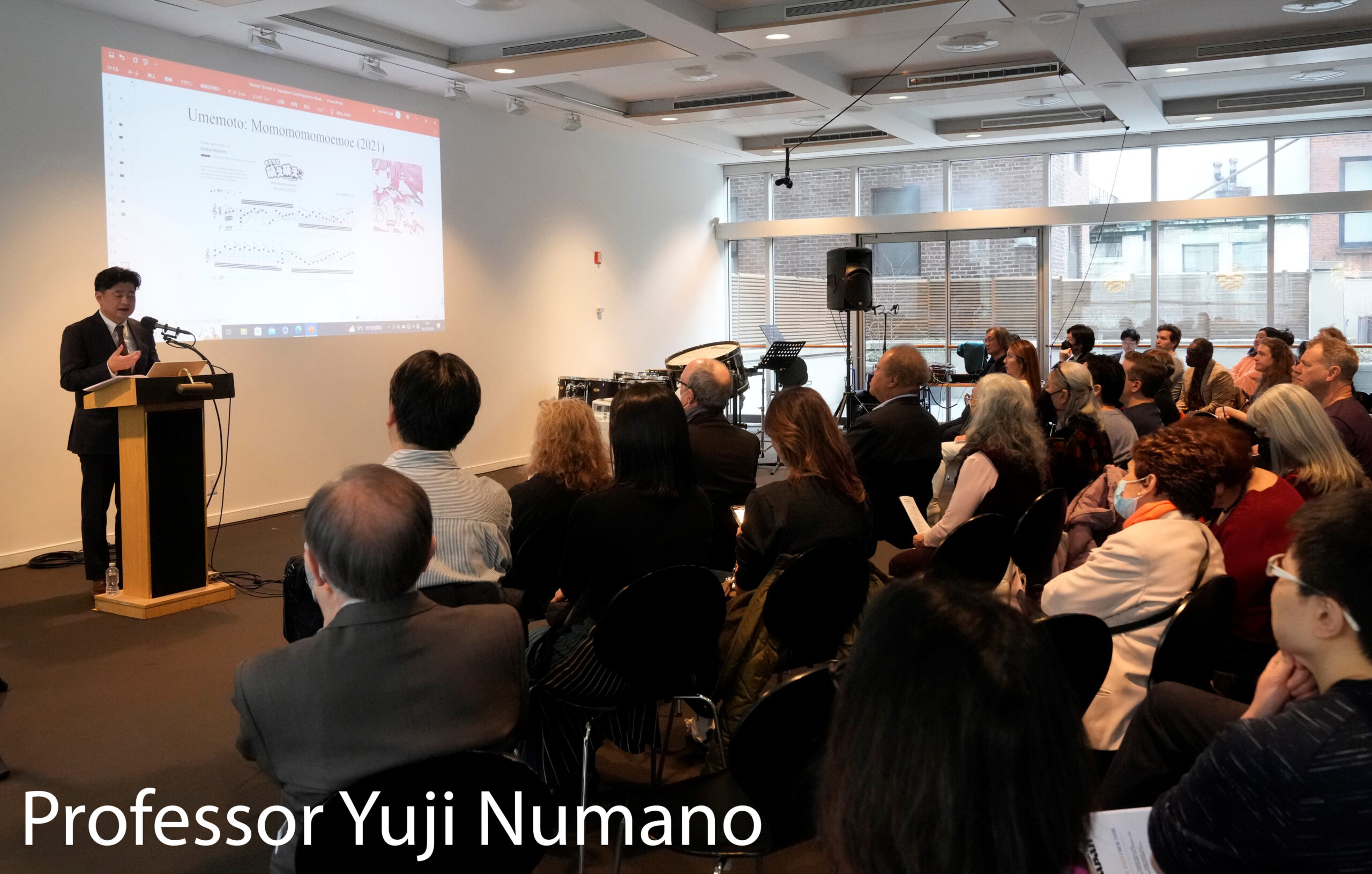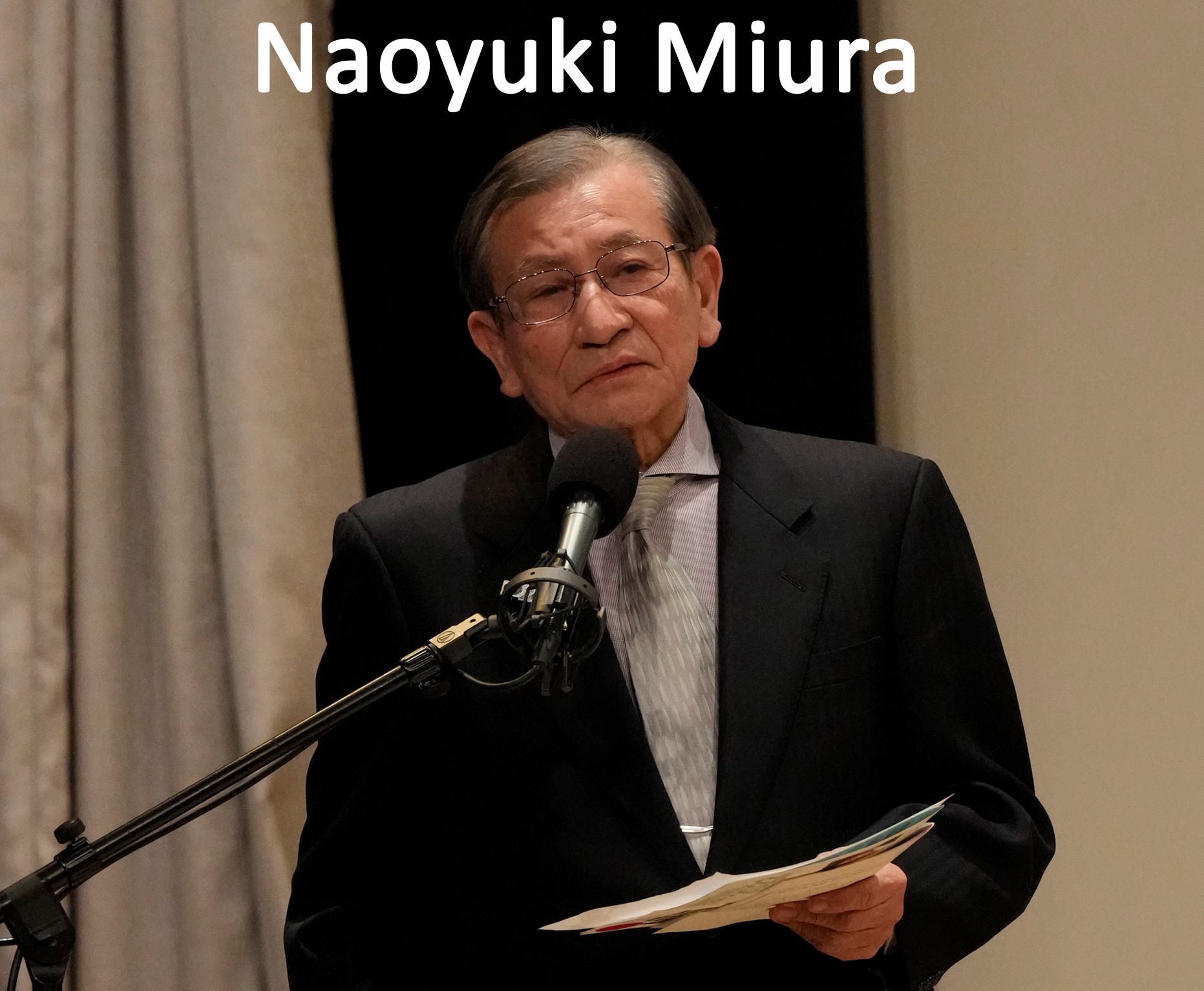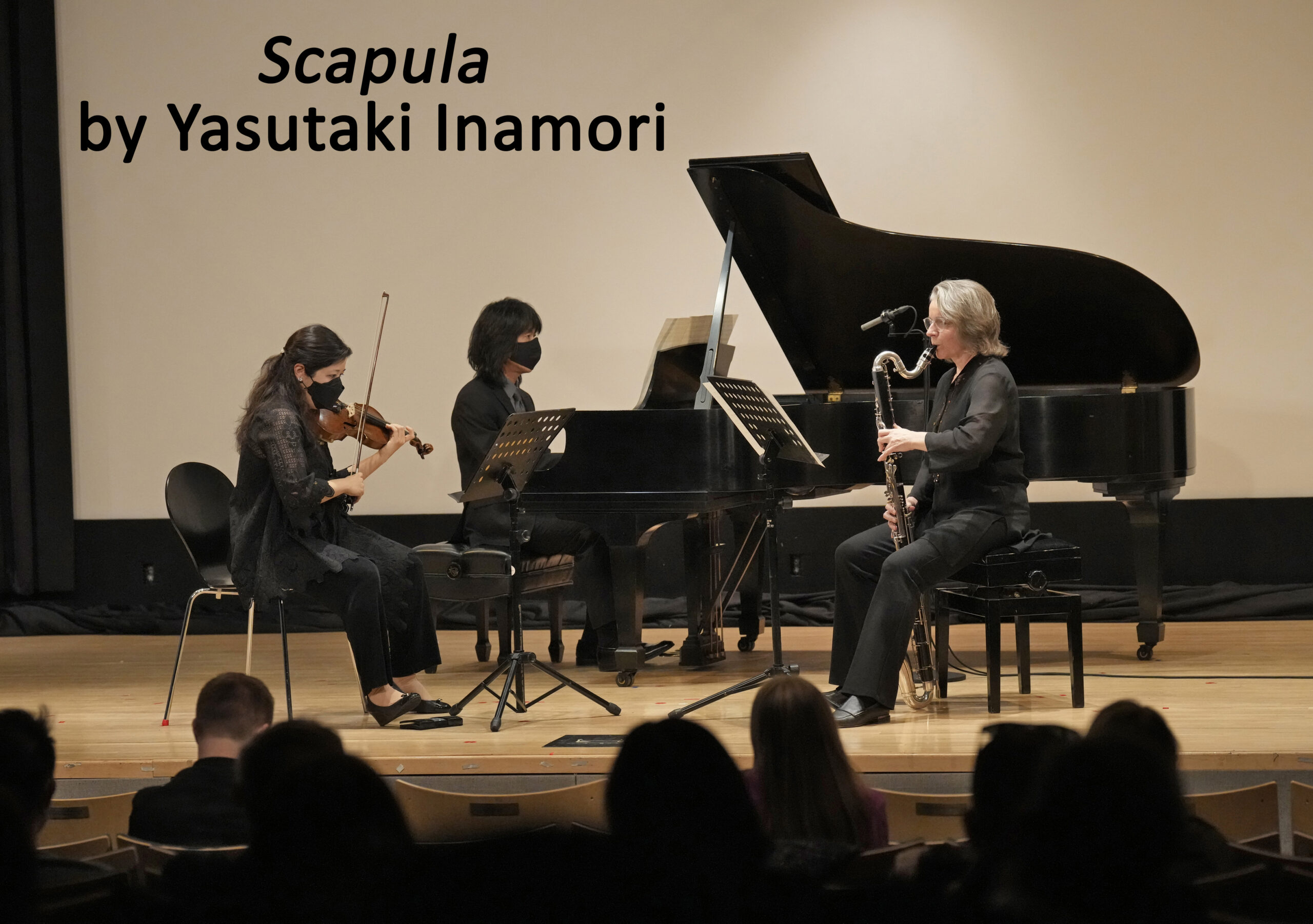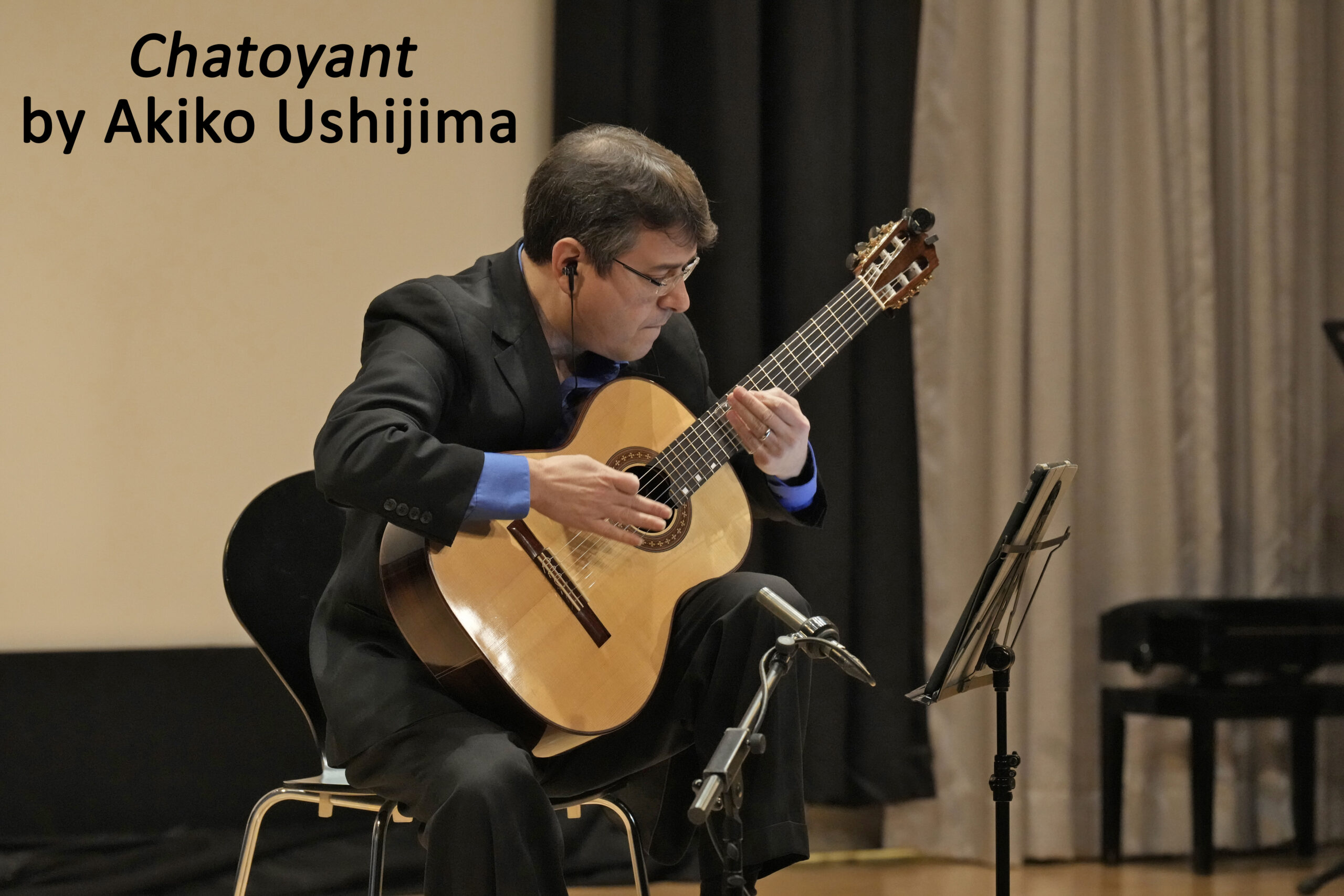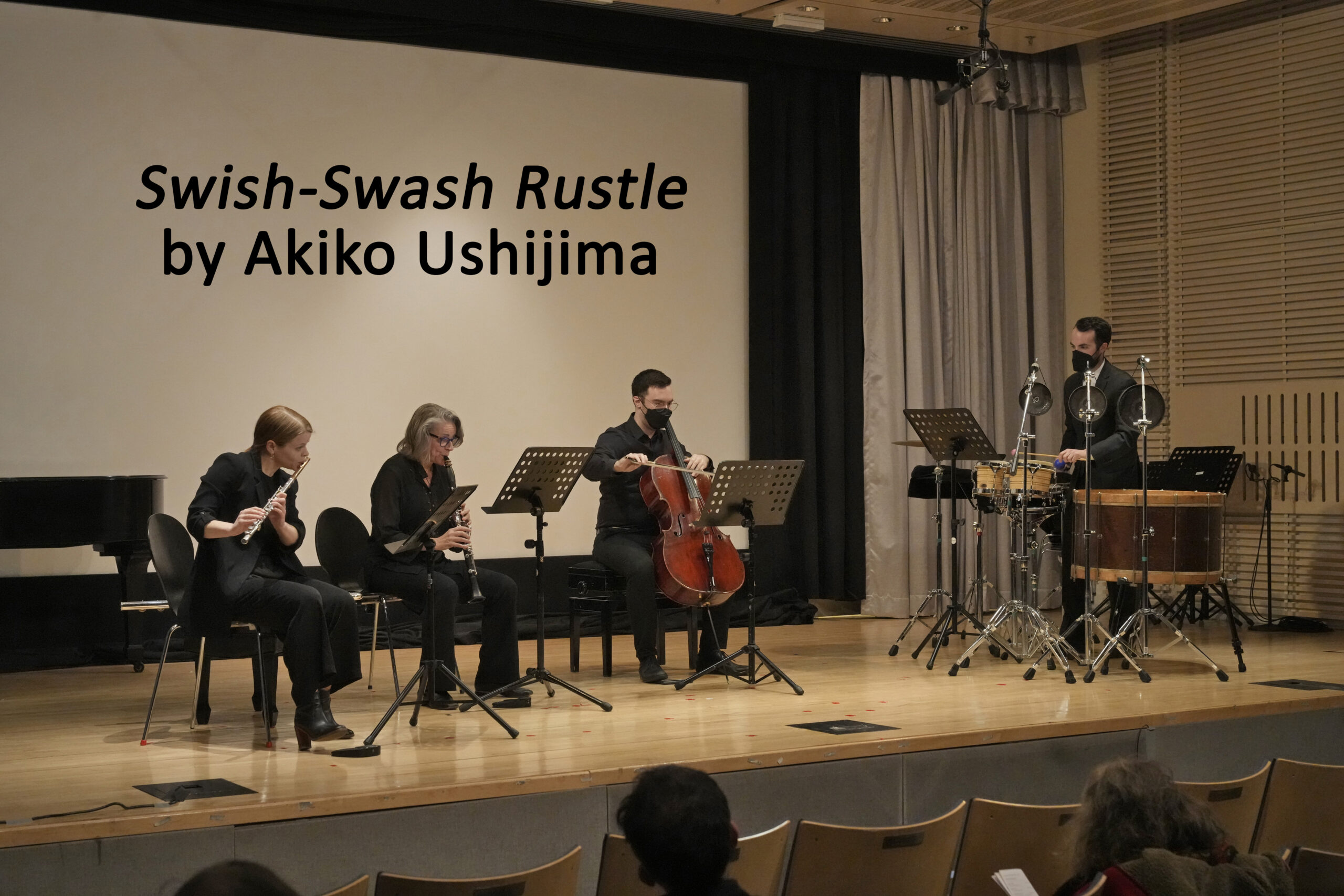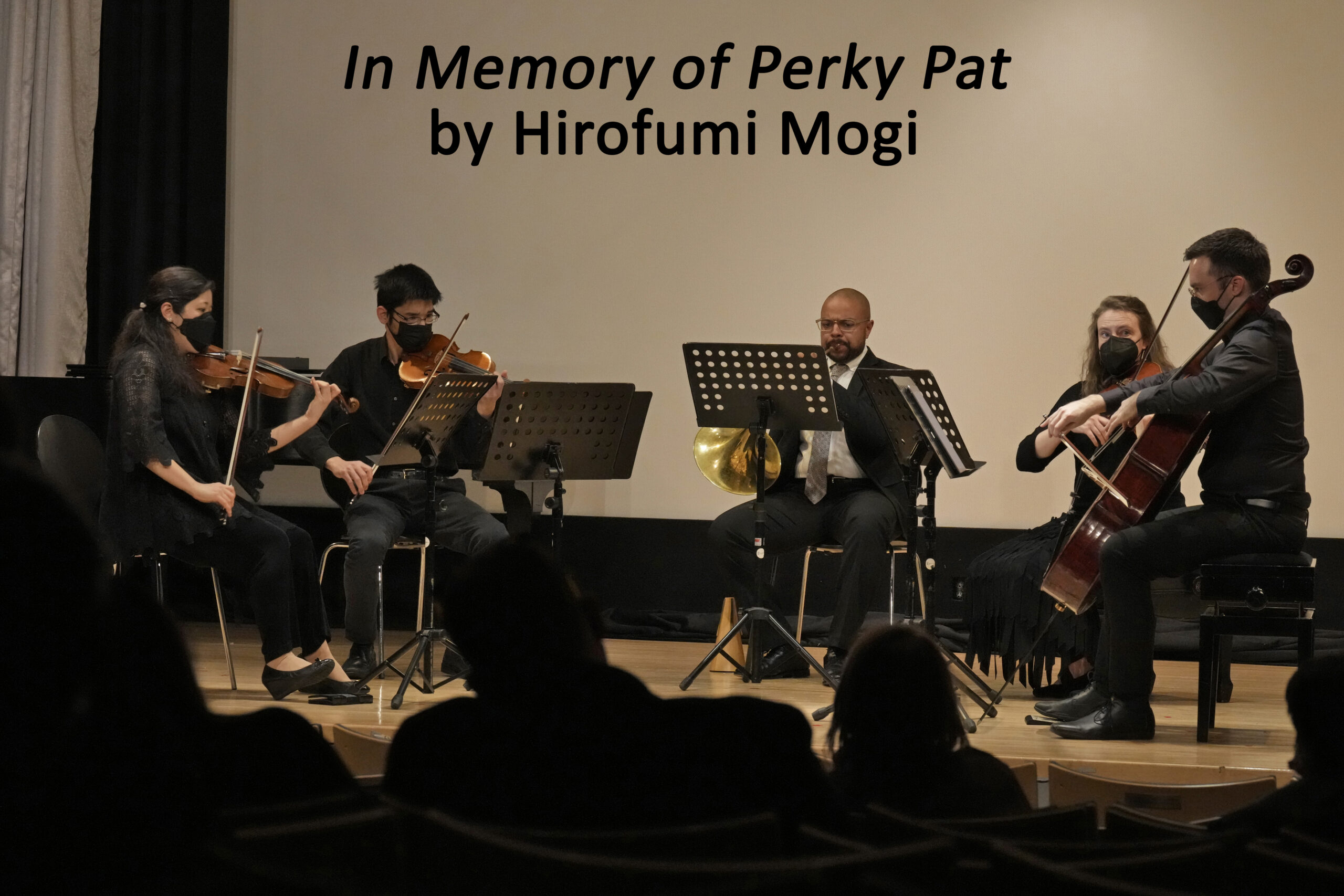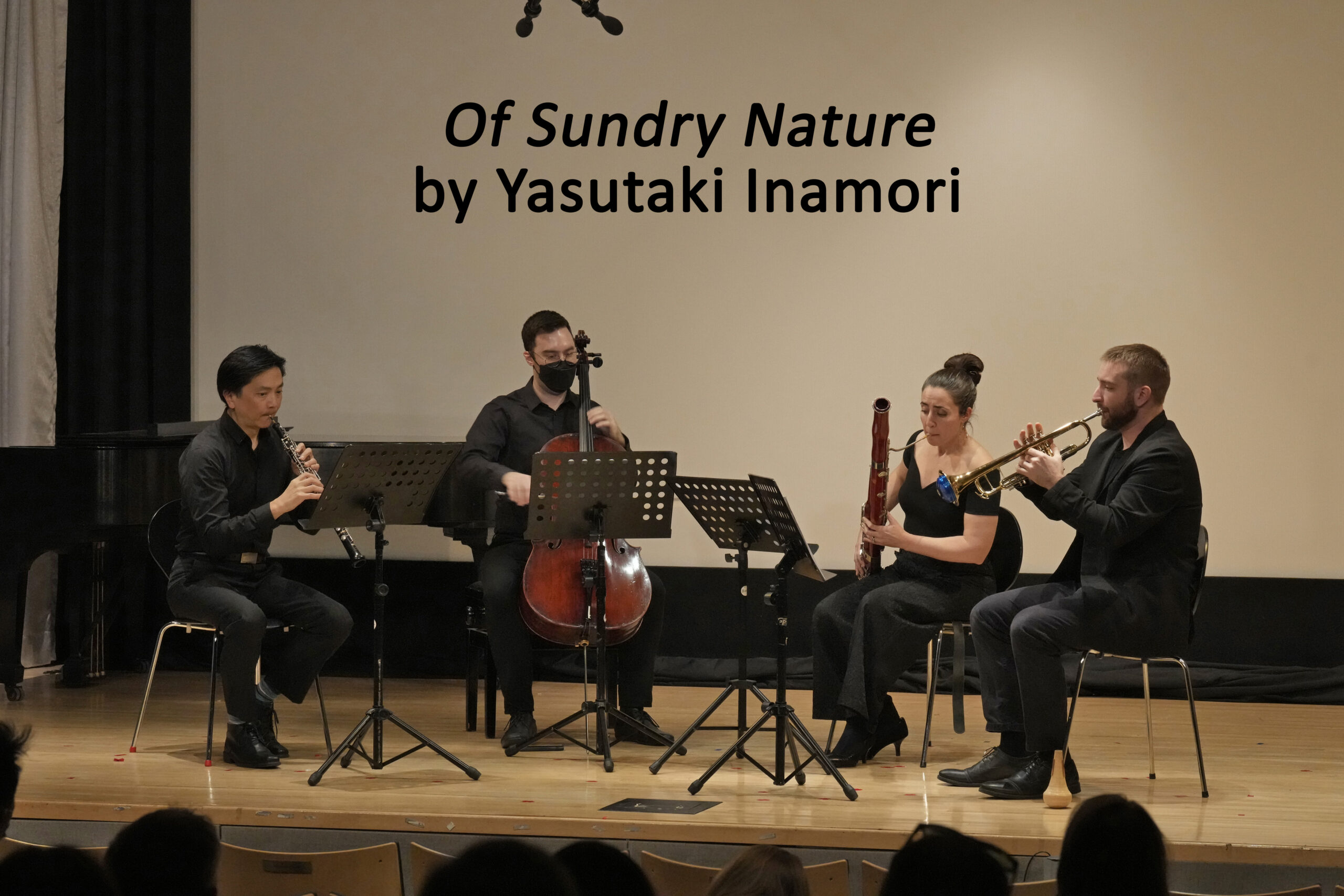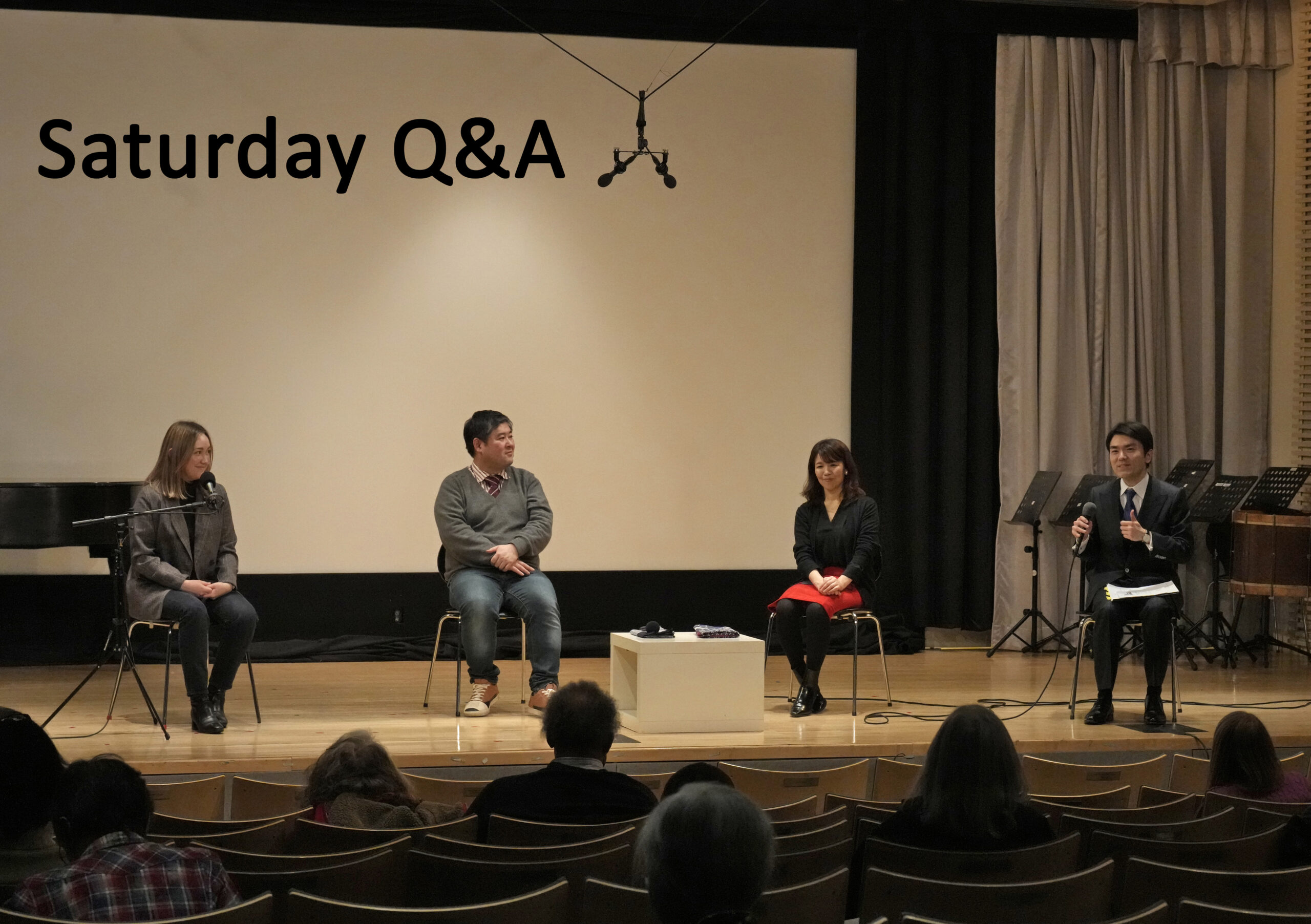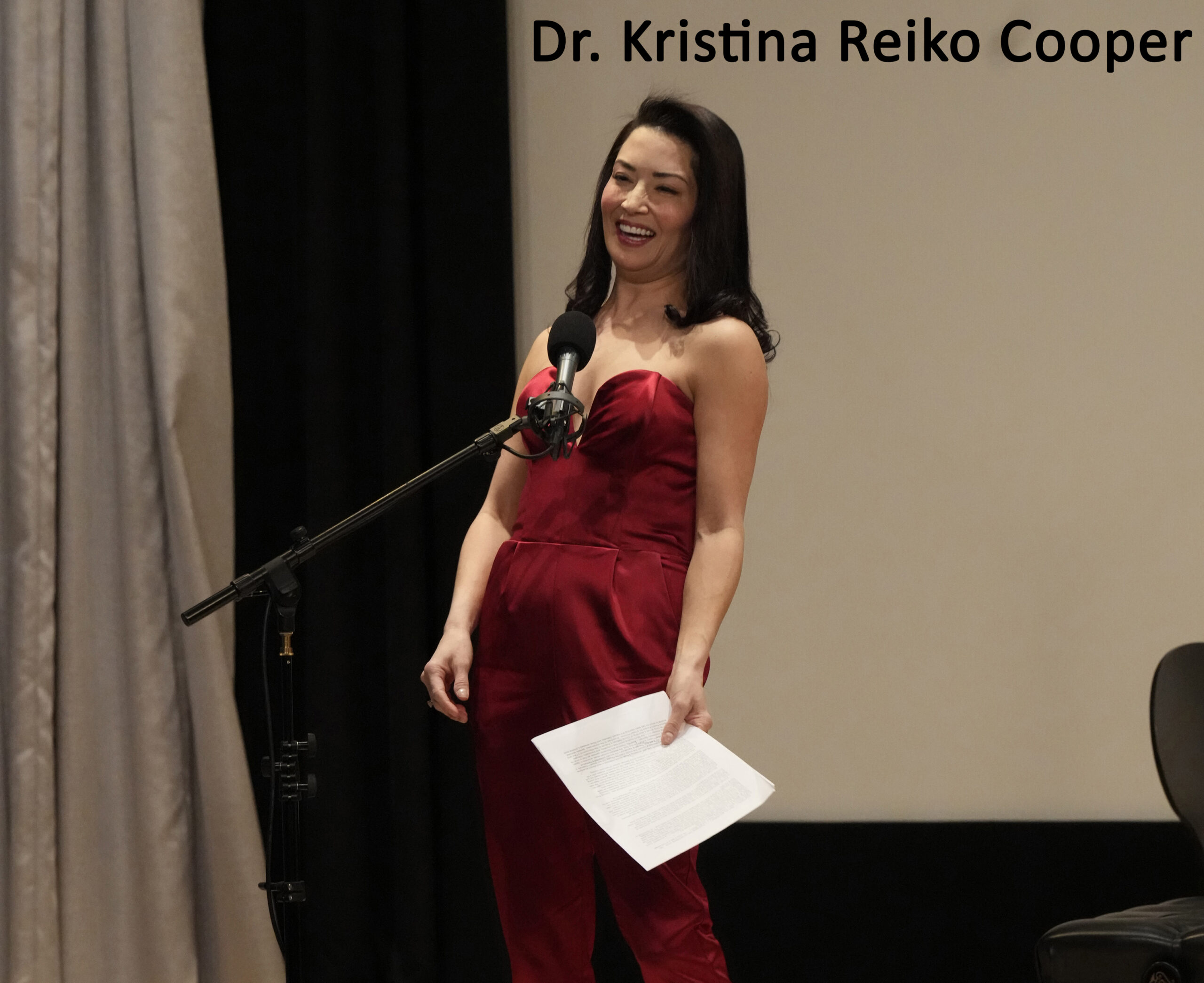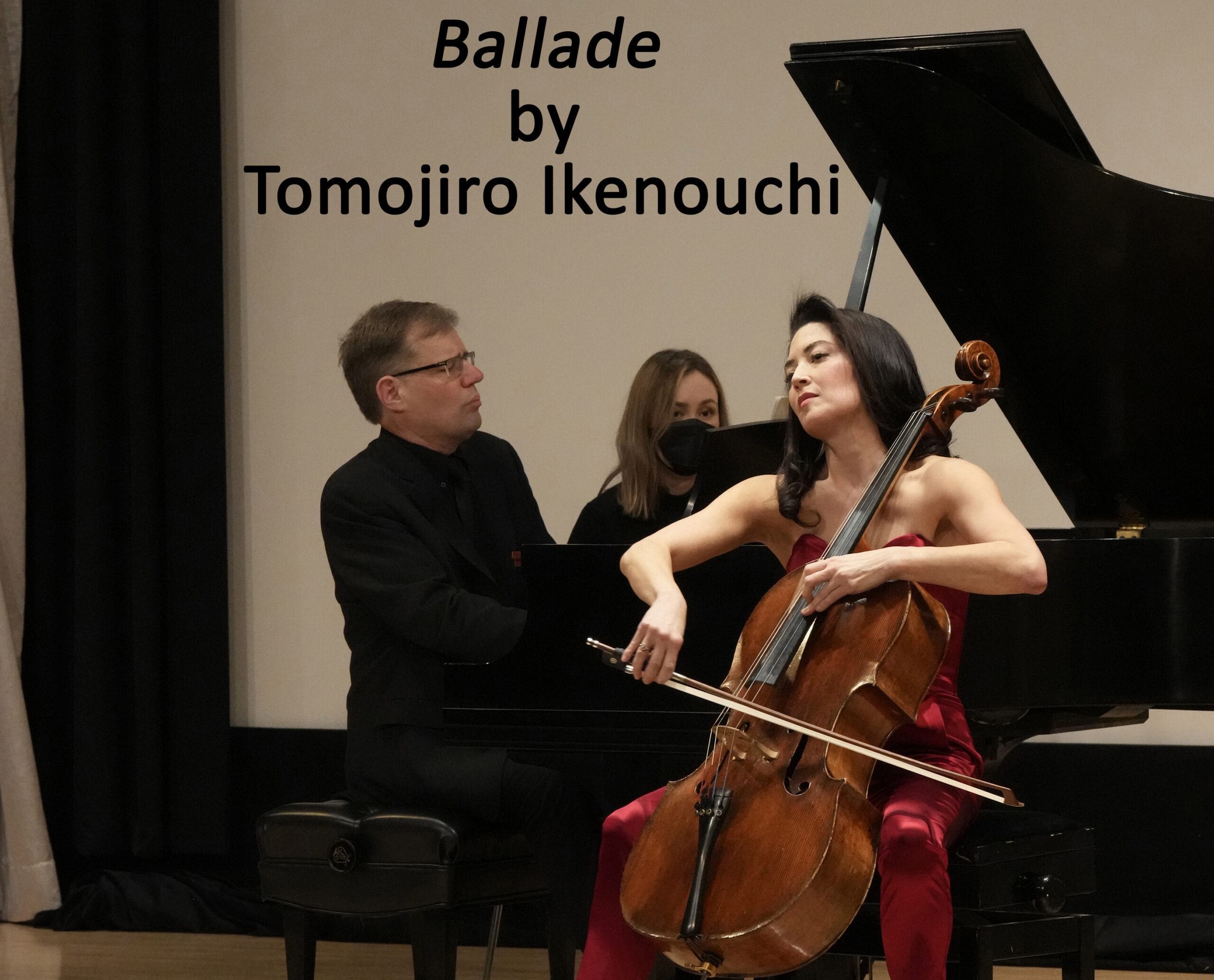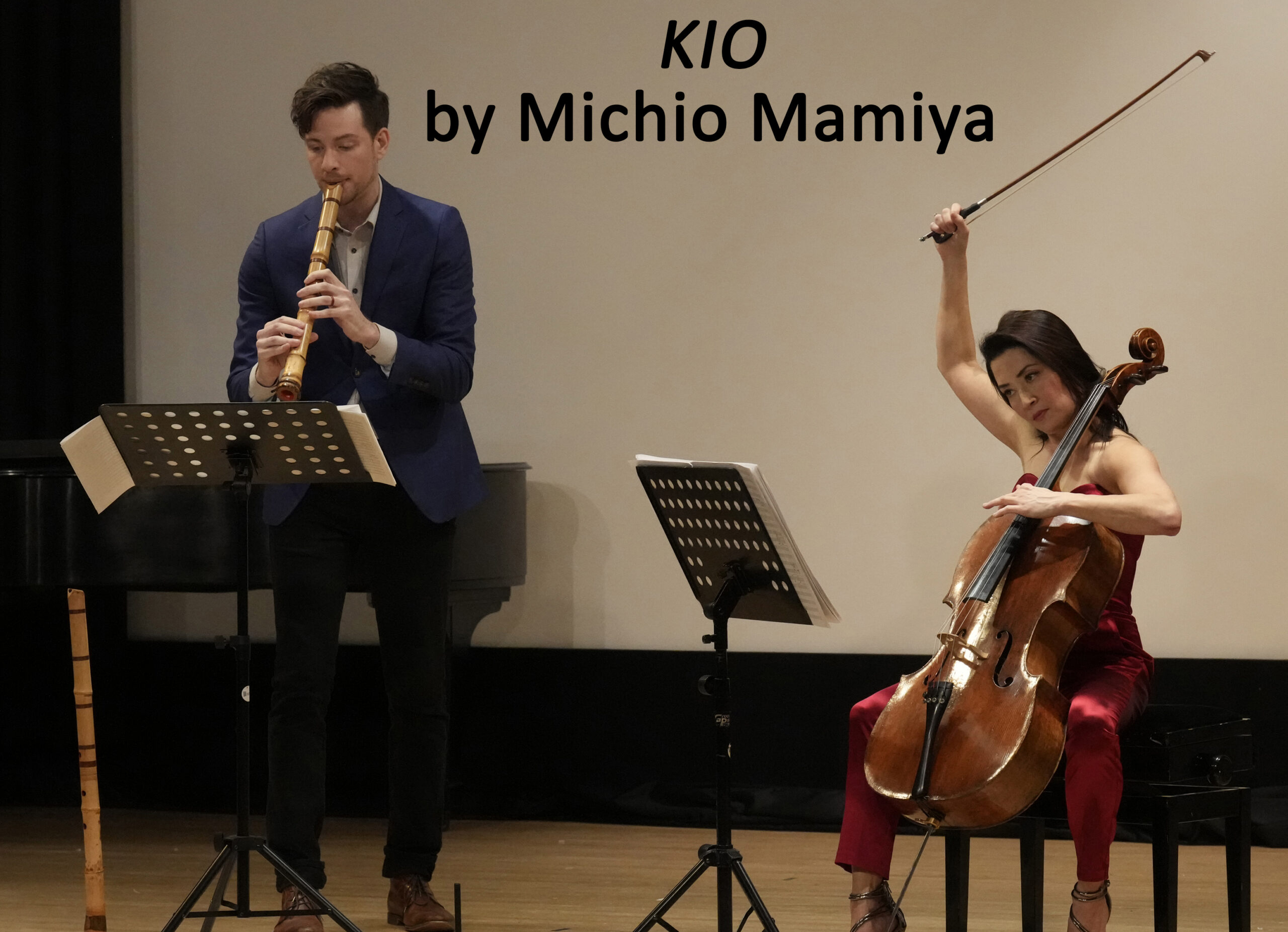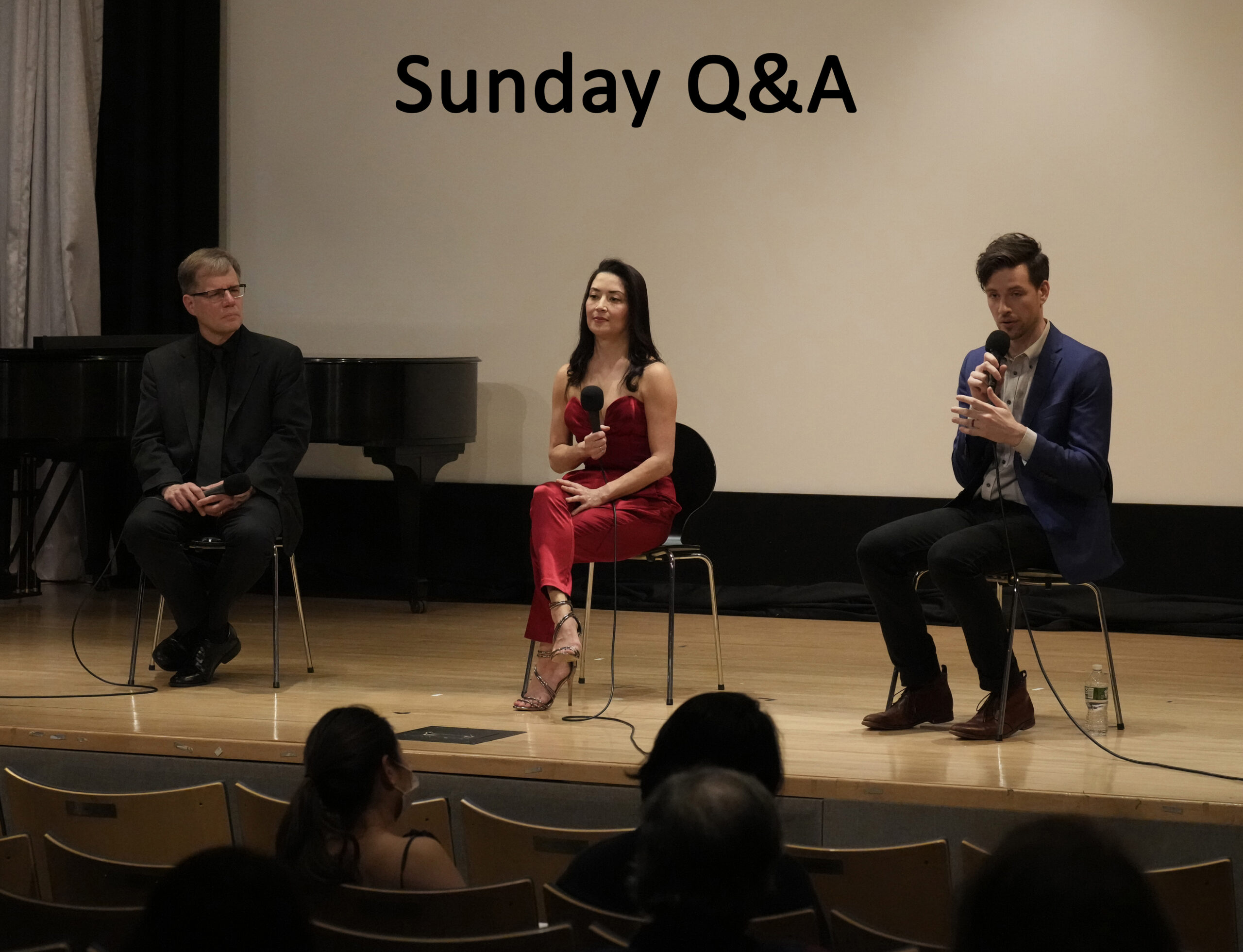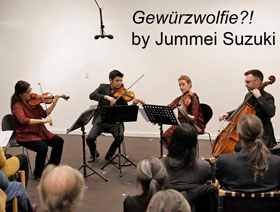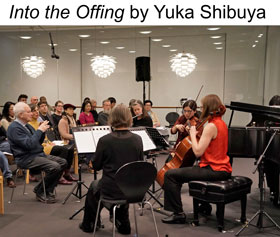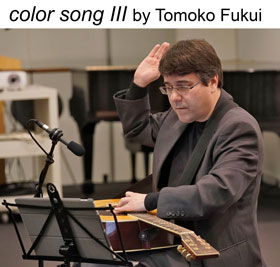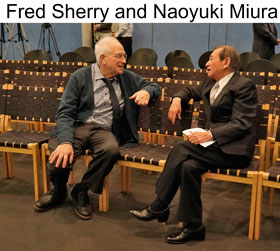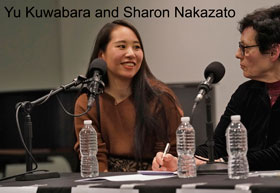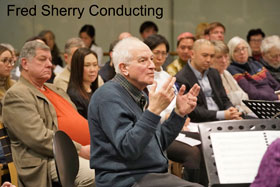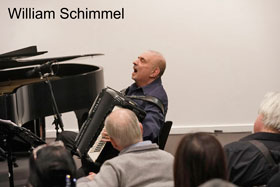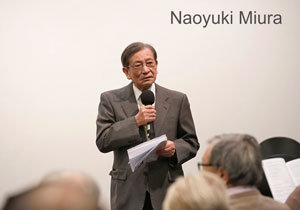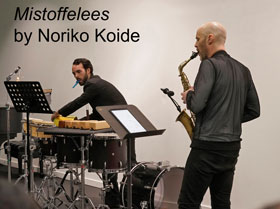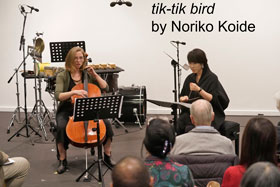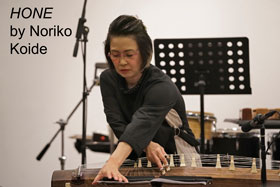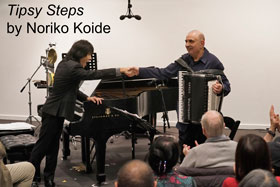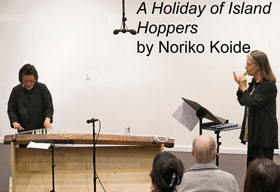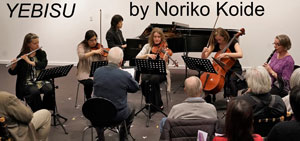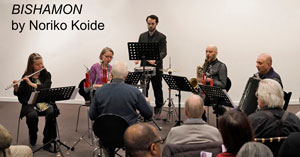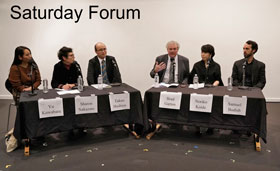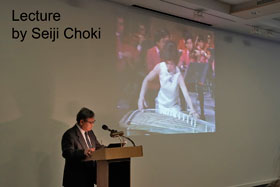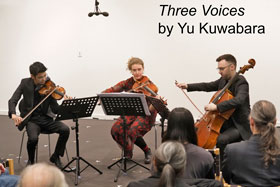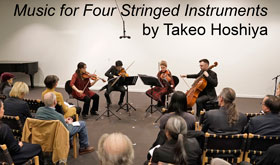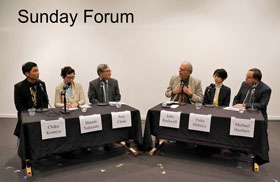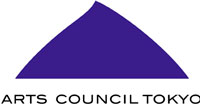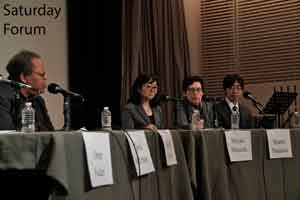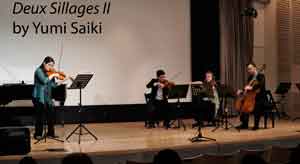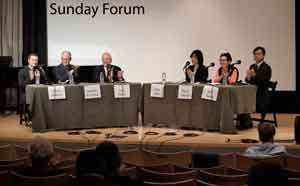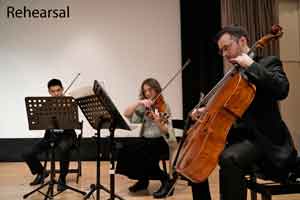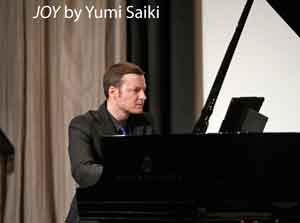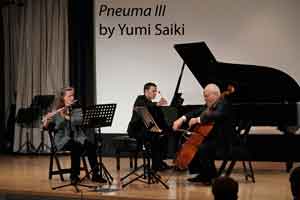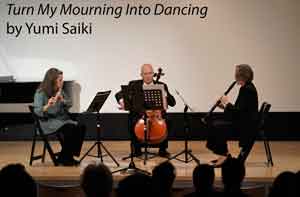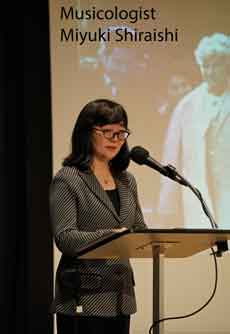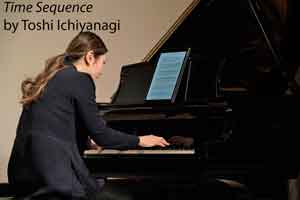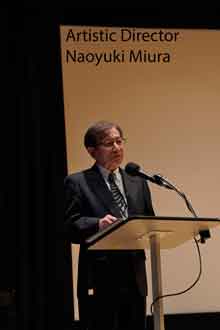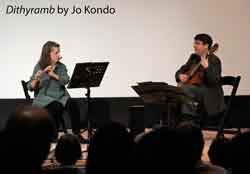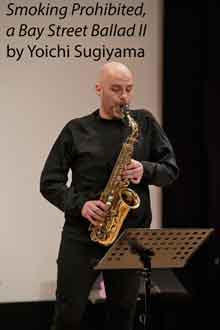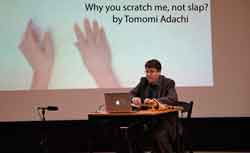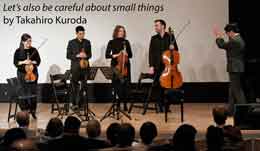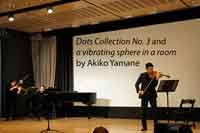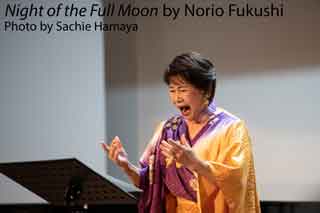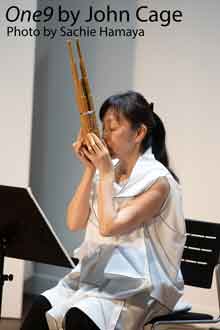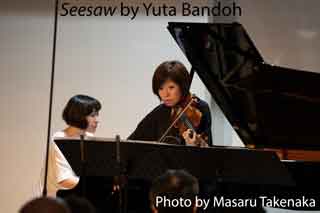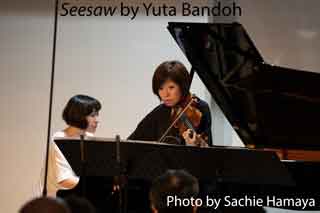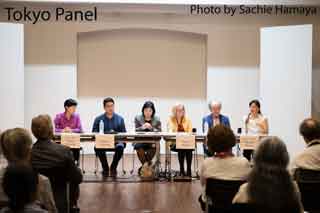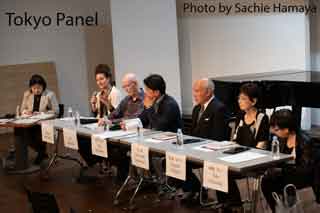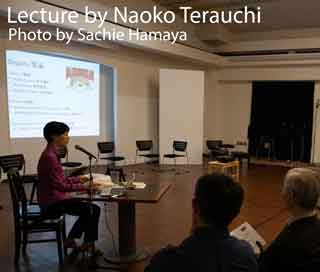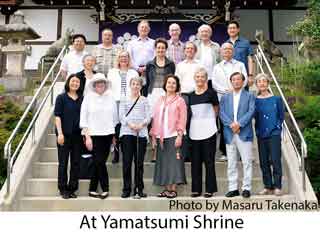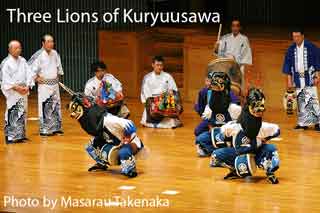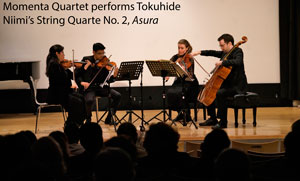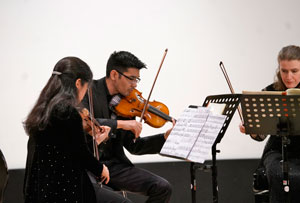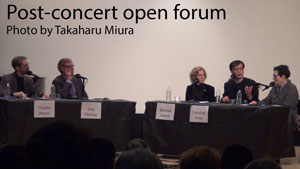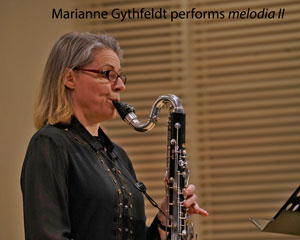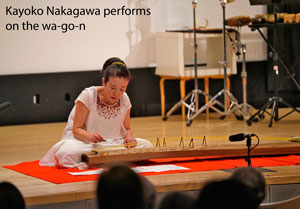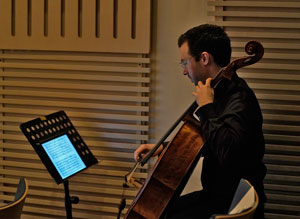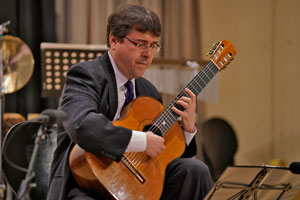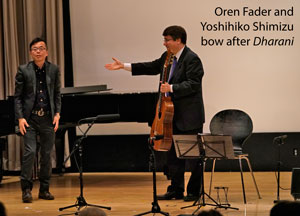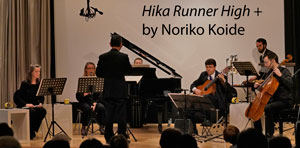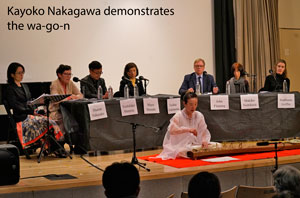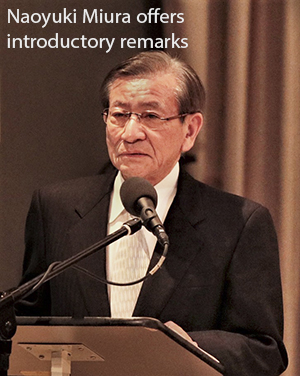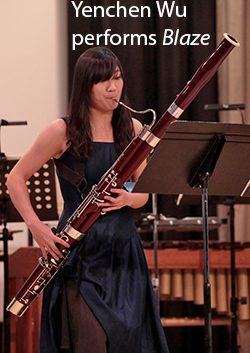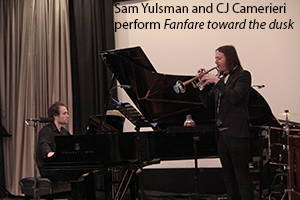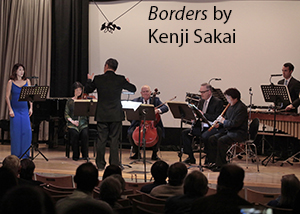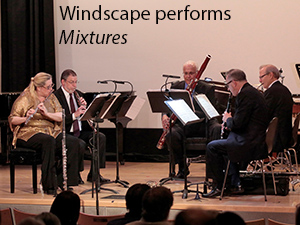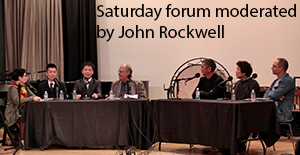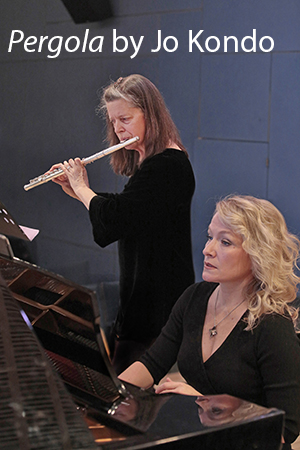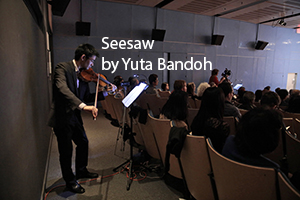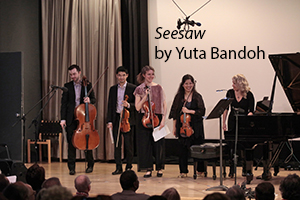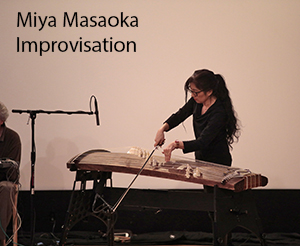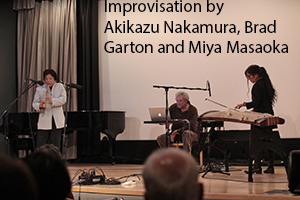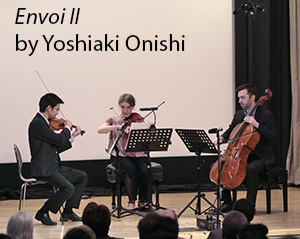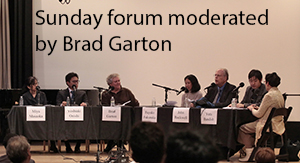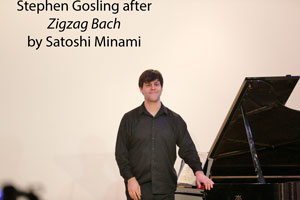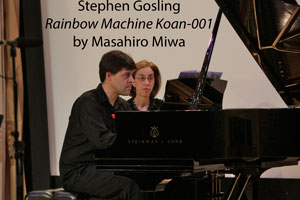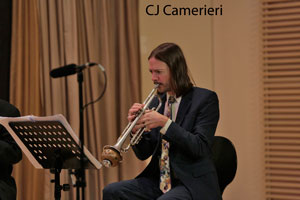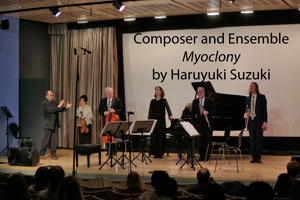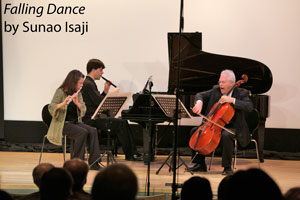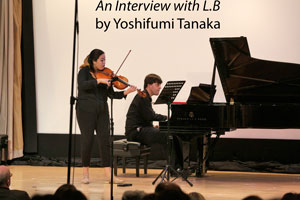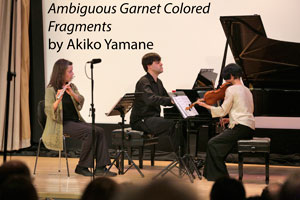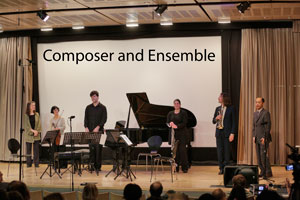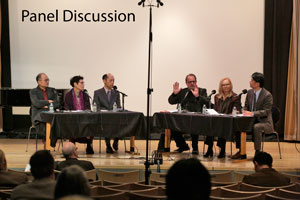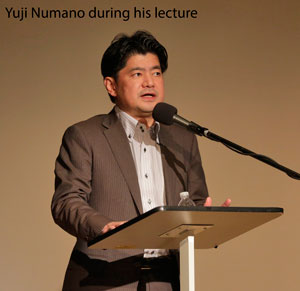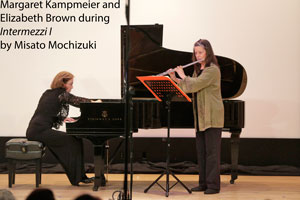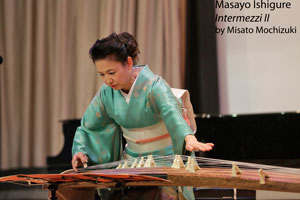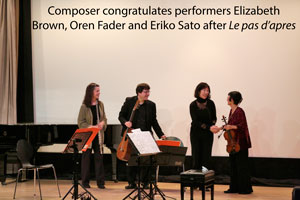
Saturday, March 9 – 7pm: Japanese Contemporary Music: Past and Present
Sunday, March 10 – 5pm: Current Sounds Japan IV
The two concerts comprising the main event of Music From Japan Festival 2024, 49th Season and Ninth Artist Residency brought together diverse and essential elements representing contemporary Japanese music. The first concert, “Japanese Contemporary Music: Past and Present”, featured an eclectic program representing over a century of Japanese contemporary music, curated by Koichi Nishi. The second concert, “Current Sounds Japan IV”, continued Music From Japan’s tradition of bringing three Japanese composers to the festival for the American premiere of recent works from their respective catalogs along with the world premiere of works commissioned by MFJ for the occasion. Both concerts were performed by some of New York’s most skilled contemporary musicians, and were supplemented by engaging and informative lectures and/or forums.
Japanese Contemporary Music: Past and Present
On Saturday, March 9, 2024, the opening concert of the Music From Japan Festival 2024 commenced with a lecture from the evening’s curator, Koichi Nishi, titled, “Japanese Contemporary Music: Its History and Current State”. As a respected concert producer and music writer with decades of experience, Mr. Nishi set the stage for the performance with his unique and erudite perspective. His lecture provided background on the composers included in the program, as well as a broader sense of the groundwork laid in the 20th century and the subsequent work built upon it in Japanese Contemporary music.
The first piece on the program was Hochzeitsklänge (roughly translated as “Wedding Music”), by Kosaku Yamada. Written in 1913 for piano quintet, this work proceeds from the beginning in a festive, yet dignified manner. The pitch set of the introductory theme (scale degrees 1-3-2-9 + Hi-sa-fu-ku) are taken from part of his name and that of his fiancé, Fuku, a fact that intimates the level of depth and thought that went into this work. The piece underscores the unity of two parts by featuring a call and response between the piano and string quartet to begin, dancing as two distinct yet deeply connected halves. This is then followed by solo moments for the piano and string quartet respectively, and finally a more intertwined full ensemble section towards the end of the work.
Second on the program was the American premiere of Kikuko Kanai’s Three Capriccios (1966). This duo for trombone and piano is distinct, not only for having been written by a true pioneer of Japanese music – Kanai was one of the first women to rise to national prominence as a composer in the western classical lineage – but also for its neo-romanticism. Contrasting with many works for similar instruments from the same time, Three Capriccios is richly tonal and unapologetically romantic, though also indebted to Okinawan folk songs and other non-western material for its melodic material. This spirit was captivatingly embodied by the performers, Jen Baker (trombone) and Taka Kigawa (piano).
Ikuma Dan’s, Two Fragments in Black and Yellow (2001) was third on the program, also receiving its American premiere. Written during a visit to Suzhou, China (as a prominent proponent of Chinese and Japanese cultural exchange), this work was Dan’s last. The piece utilizes the full lushness of the string quartet – especially its lower register – while adding to it the dynamism of a solo violinist, in this case the vibrant playing of Miho Saegusa. The result combines an aesthetic rooted both in the second Viennese school and the French impressionism of that same period, while also offering something completely its own. The work oscillates between light and dark, the former emanating from the solo violin and the latter from the cello-driven string quartet material, evoking an emotional scale worthy of the master’s late period.
After a brief intermission, the program continued with Bansho (2019), by Yutaka Takahashi. We were lucky enough to have Mr. Takahashi present at the festival, and to have him perform the HiFuMi KamiUta (a Shinto ritual prayer) in the style of Noh dance and song. Performing alongside him was Taka Kigawa on piano. The performance was potent and moving, evoking fully the notion of Amida Buddha and the ritual worship of the setting sun – both ideas are embedded in the title, Bansho, which roughly translates to “late illumination”.
The evening’s music concluded with the world premiere of Shion Sahara’s newest piece, GPGP — The Great Pacific Garbage Patch — (2024). Written out of an effort to more deeply engage with issues of pollution, and to learn more about the namesake body of debris in particular, this work utilizes the duo format to suggest a conflict between nature and polluting forces; the former represented by the viola and the latter the trombone. As happens often with newly written contemporary music, the performers (Jen Baker and Stephanie Griffin) were engaged as collaborators in a sense, working together to overcome the rich technical challenges presented by the score. Along with this, props of detritus on stage created both an improvisational and theatrical character, unique to the moment and the character of the performance. Overall, it was an exciting and humorous end to the evening.
After the performances, longtime friend to Music From Japan, John Rockwell moderated a Q&A with Mr. Nishi, Mr. Takahashi and Jen Baker. They discussed the historical arc of the program, inquiring about the stylistic associations one could hear in the music, the rehearsal process for each piece and more.
CURRENT SOUNDS JAPAN IV
The final event of Music From Japan Festival 2024, Ninth Artist Residency and 49th Season took place on Sunday, March 10. “Current Sounds Japan IV” brought three dynamic Japanese composers working today to New York for the American premiere of recent works from their respective catalogs, to be presented alongside a brand new work commissioned by Music From Japan for the festival. Chiharu Wakabayashi, Mayuko Kawasaki and Koji Fukumaru presented works ranging in method, source material and style, all performed by a collection of New York’s finest contemporary instrumentalists.
The program’s first half featured a recent composition from each invited composer, none of which had been played in the US before. First up was Dashing out Kid V (rev. 2022) for accordion solo, by Chiharu Wakabayashi. WIlliam Schimmel performed this stark work with a captivating patience, reveling in its many silent, or nearly silent, passages. This tone was fitting of the composition’s inspiration, a “dashing out kid” graphic so ubiquitous in Mr. Wakabayshi’s home prefecture, it’s easy to ignore. This piece asks us to slow down and look more closely at what surrounds us.
Cicada’s Wings, Weaving Song (2022) came next – a playful and rhythmically driven duo for flute and koto by Mayuko Kawasaki. The piece employs various preparations for the koto, and auxiliary sound sources for both performers. As with many other works featured on the festival, Cicada’s Wings, Weaving Song uses the duo format to articulate a particular duality in sound – in this case the duality of the raucous noise produced by cicadas (flute) and the weaver’s loom (koto) from Niigata Prefecture, which can be used by a skilled operator to weave silk that approaches the delicacy of those same cicadas’ wings. Laura Cocks and Masayo Ishigure were able to balance their distinct roles with a cohesive duo sound, which seemed at times to come from an even larger grouping, with the help of the aforementioned preparations and sound sources.
Koji Fukumaru’s Figless II (2022) finished the first half of the concert. A timbrally rich and dynamic piece of music written for vibraphone, viola and cello, Figless II derives its name from the Bible’s New Testament. However, its driving force is purely musical in the composer’s description of it – “the music is intended to explore novel acoustic effects against the continuous background of fluctuating harmonies”. The virtuosity required to achieve this was no small feat, as the musicians were required to execute material spanning from the familiar and tonal to the extended and experimental, sometimes within a few bars.
After a short intermission, the program resumed with commissioned works from each composer – all world premieres. Reversing the order of the first half, Koji Fukumaru’s new piece, Figless III (2023) came first. This new edition to Mr. Fukumaru’s series augmented the instrumentation from Figless II, keeping the vibraphone, cello and viola, and adding to it both piano and accordion. In fact, Figless III started out as a shorter third movement for Figless II – once it became clear the form did not benefit from this third section, Mr. Fukumaru decided to develop it into its own piece. Figless III stands out in contrast to its predecessor, utilizing the larger instrumentation to produce a more festive and almost dance-like energy.
Next came Mayuko Kawasaki’s Nonexistent, or LIke a Flash (2024), for baritone saxophone and string trio. Drawing on her love for modern Japanese poetry, Ms. Kawasaki delved into Ryoji Asabuki’s collection, Misshitsu-ron (The Closed Room Treatise) for inspiration. More specifically, she drew upon the poet’s use of the word “nai” – a word with a nuanced meaning; “not, or nothing, does not, none, missing”. These subtly different interpretations of the word translated into compelling music in Nonexistent, or Like a Flash, yielding a wide range of timbres, rhythms, dynamics and densities.
The final commissioned work, and final work presented at the Music From Japan Festival 2024 was Chiharu Wakabayashi’s tree*wood*forest……. TRI-ODE II (2024). Perhaps the most technically difficult work on the program, this piece for viola, cello and contrabass was immediately distinct in its use of hocketing rhythms, relying on each player to embody a distinct rhythmic cell from their colleagues. The task was difficult enough that Mr. Wakabayashi assisted by conducting the piece. But the result was well worth it and executed with aplomb. As the composer himself described, we heard “contradictory times [that] are shared, reciprocated, and contained within each other”.
The program was followed by a forum with the commissioned composers, cellist Christopher Gross, and music critic Susan Brody, all moderated by Fred Sherry. The forum covered the range of materials, methods and style exhibited not only amongst the commissioned composers but also by each composer respectively, as well as the demands put on the instrumentalists to learn the pieces, and much more.


Saturday, March 4: COLORS: Contemporary Vocal Works of Japan
Sunday, March 5: Current Sounds Japan III
Music From Japan Festival 2023 New York Program
The two concerts comprising the main event of Music From Japan Festival 2023 New York, 48th Season and Eighth Artist Residency showcased the breadth and craftsmanship of Japanese music today. The first concert, “COLORS: Contemporary Vocal Works of Japan”, featured a program of vocal works assembled by curator and music critic, Akane Matsudaira. The second concert, “Current Sounds Japan III”, brought three Japanese composers to the festival for the American premiere of recent works from their respective catalogs along with the world premiere of works commissioned by Music From Japan for the occasion. The composers – Akira Ito, Madoka Mori and Yoshihiro Kanno – drew inspiration from musicology, sociology, ritualistic music and more, culminating in captivating and eclectic work. Both concerts were performed by some of the most impressive players from New York’s contemporary music world – preceded by informative lectures and followed by an open Q&A or forum with performers and/or composers.
COLORS: Contemporary Vocal Works of Japan
On Saturday, March 4th, 2023, the opening concert of Music From Japan Festival 2023 New York commenced with a talk by Akane Matsudaira titled, “Contemporary Vocal Works of Japan – from a singer’s perspective.” As a renowned soprano in her own right (as Akane Kudo) she was uniquely equipped to shed light on myriad salient points – regional Japanese vocal musics, lyrical content on the concert program, notational systems and even sumo wrestling. The eclectic program that Ms. Matsudaira assembled showcased a diverse and rigorous glimpse of Japanese vocal music’s vibrancy – grappling with such questions as the legacy of serialism, the setting of haiku and translation – all the more enjoyable after her illuminating talk.
The first piece on the program was Mari Takano’s Two Chansons, for soprano and piano. Composed in 1997, the piece stems from literary inspiration (Graham Greene’s The End of the Affair and N.P. by Banana Yoshimoto for each half of the piece, respectively). The work utilizes repetition of particular notes in the vocal part – performed by soprano Wonjung Kim – as direct allegories for lingering thoughts and feelings regarding a past love. This repetition is contrasted, supported and even overshadowed at times by the piano part, played by Rieko Aizawa. Though the work continually returns to its repetitive nature, the music is increasingly abstracted in favor of movement and modulation until the end of the piece.
Second on the program was Etudes Lunaire, by Motoharu Kawashima – the performance of this work, along with the remainder of the program, was an American Premiere. Etudes Lunaire works as a kind of refraction of Arnold Schoenberg’s seminal piece, Pierrot Lunaire. Mr. Kawashima used the raw elements of Schoenberg’s work, specifically the formal significance of the number 21, to define the vocabulary of his piece. The result is 21 distinct vocal techniques that are arranged and sung disjointedly, in an “extreme and condensed manner.” Akane Kudo delivered an electric performance of the piece.
Rica Narimoto’s work, The Sound of Water from Basho’s Haiku, was third on the program. Completed in 2012, the piece was first conceived as a musical setting for text from Japanese haiku. After conducting exhaustive research into possible haiku to draw from, Ms. Narimoto decided to feature the work of the renowned poet, Basho (1644-1694). Taking it one step further, she translated the text into English herself, resulting in an interpretation bespoke to the expressive impact of Basho (as she felt it) and the musical effect she hoped to have as a composer. The text was delivered exquisitely by the American bass-baritone, Michael Kelly.
After a brief intermission, the concert continued with Three Autumn Songs b (2nd & 3rd sections only) by Masamichi Kinoshita. This duet was composed as a tribute to Masanori Taki, a calligraphy artist of particular importance to the community around the Takefu International Music Festival in Echizen City, near Mr. Kinoshita’s hometown. The original instrumentation, however, was for mezzo-soprano and flute – before several alternative versions for various instrumentations were produced, such as the one for mezzo-soprano and violin featured on this concert. Wonjung Kim delivered the text, sourced from three poems by Jukichi Yagi, with the necessary balance of expressiveness and solemnity to evoke the intended tone of late autumn. This tone was beautifully supported by Jesse Mills’ nuanced interpretation of the spacious, contrapuntal violin part.
The next piece, Hiroyuki Yamamoto’s Umi-no Mieru Fukei (The Landscape with Ocean View), featured Ms. Kim again, this time in another duet with pianist Rieko Aizawa. Inspired by the sea poetry of Yukari Kojima, Mr. Yamamoto composed a poignant work with succinct use of materials. Setting four different poems to the same melody in the vocal part, the piece highlighted the changes in color and mood by placing each poem against the same pitch-material. This effect was augmented by the piano accompaniment, which varied greatly from setting to setting.
The program continued with a piece by Sachiyo Tsurumi, entitled Kamoshika. Deconstructing the word, “kamoshika”, Ms. Tsurumi chose particular characters to imbue it with a dual meaning – one being a gazelle and the other a nuanced expression of a particular sake and a spiritually-infused notion of its brewing. With these meanings in mind, she composed a work that alternated between tones that might be associated with those meanings; a more driving section, evoking the speed and buoyancy of a gazelle, followed by a gracefully somber, slow and undulating section. Given the feeling of the piece, it is not hard to see why it was originally arranged to include dance.
Fittingly, the concert finished with a vocal duo – Recitativo and Aria by Yoriaki Matsudaira (1931-2023). Originally commissioned by Akane Kudo and Takashi Matsudaira, this work was conceived as a re-structuralist approach to an old-fashioned form. The piece utilizes Japanese, French and German, deconstructing the grammar of each towards a result the composer described as an “anagram” of all three. Despite the classical implications of the title, Recitativo and Aria presented the audience with a dazzlingly playful (not to mention extremely challenging to perform) piece of music. Sadly, Mr. Matsudaira passed away shortly before this American premiere of the work; the performance was dedicated to him.
“COLORS: Contemporary Vocal Works of Japan” was concluded with a thought-provoking Q&A with all three singers from the concert – hosted by Matthias Kriesberg.
CURRENT SOUNDS JAPAN III
The second concert of the festival took place on Sunday, March 5, 2023 and featured the work of three artists whom Music From Japan awarded its Eighth Artist Residency. Yoshihiro Kanno (Chairman of The Japan Federation of Composers), Madoka Mori and Akira Ito were each commissioned to compose one new work for this program, to be played along with another from their existing body of work. The concert was preceded by a lecture by Professor Yuji Numano from Toho Gakuen School of Music, titled “Recent Trends in Japanese Contemporary Music”, which spotlighted four Japanese composers (each from a different generation) actively working today. Such topics as robotic performers, coding as source material for music, A.I. utilization and popular music’s influence were discussed along with audio samples.
The first half of the program featured the American premieres of each composer’s selected work. Madoka Mori’s Vocalise (2018) for cello solo – performed by Christopher Gross – was originally conceived as an encore for her cello concerto, Atrium. Utilizing the inherent harmonic language of the cello and an equal use of both pizzicato and arco articulations, Ms. Mori was able to work with explicitly melodic material in a style that both subverts and features the more traditional vocal approach to melodic playing suggested by the title and often associated with the cello.
Next came Yoshihiro Kanno’s work for piano and Nambu bell (made of cast iron from Nambu), titled A Particle of Light (2009). The piece showcases the full range of the piano, with a slow pulse and a palette that’s more harmonic (even textural) than melodic. A Particle of Light has a symbolic meaning that plays out formally as the work progresses. In his liner notes, Mr. Kanno draws a parallel between the iron materials used to make both the bell and the piano strings, but makes a distinction between their Japanese and Western origins, geographically and culturally. This framing adds a depth of meaning to the interplay between these two ‘iron sounds’.
Third on the program was Akira Ito’s Even a Chance Acquaintance is Decreed by Destiny (2021), a trio for cello, accordion and bass clarinet inspired by (as the name would suggest) the potential long term effects of even the most banal social interactions. In Mr. Ito’s liner notes for the piece, he says “this work is a careful consideration of the elements of sound and their relationships from multiple viewpoints”, and that social framing of the material comes through in the music. Complex multiphonics, spectral gestures, sharp attacks and more are constantly re-arranged in relation to one another, evoking a kind of sonic collage rather than a more familiar linear form.
The second half of the concert showcased the newly commissioned works by each composer, all of which were world premieres. Madoka Mori’s piece, Prologue for string quartet was first. Again, she took inspiration from a traditional title to expound upon and stretch the typical meaning it carries. In this case, Ms. Mori is pondering the threshold that has been crossed as a society in our collective experience of the COVID-19 pandemic, and has reflected that sense of something new changing the inherited world (that we are in the prologue to a new era). More specifically, this meant using triadic harmonizations of the piece’s core motif in innovative and subversive ways – new uses of older materials. The result is a piece of music both eerily familiar and surprisingly fresh at the same time.
Next on the program was Akira Ito’s piece for string quartet, The Strength of Weak Ties. In keeping with his sociological interest, Mr. Ito took titular inspiration for this work from Mark S. Granovetter’s 1973 paper of the same name (he also noted that this work is an extension of the ideas explored in Even a Chance Acquaintance is Decreed by Destiny). Using Granovetter’s notion – of the potentially greater power that weak social ties have over more familiar ones to bring unexpected and life-altering information into our lives – as a formal jumping off point, he composed a compelling work where the relationships between what each member of the string quartet is playing oscillates between total unity and stark juxtaposition.
Both Prologue and The Strength of Weak Ties were performed by Momenta Quartet.
The final piece of the concert was Imaginary Ritual by Yoshihiro Kanno. Using the rhetorical rhythms and tones from a particular Sanskrit incantation as the basis for the work, Mr. Kanno sought to create an “imaginary ritual raising ‘Prayers to the Stars’”. Written for a quintet featuring piccolo/alto and standard C flute, bass and Bb clarinet, violin, cello and percussion, Imaginary Ritual establishes a rhythmic unison within the ensemble that is maintained throughout much of the piece. When combined with the heft of the bass clarinet and the thematic insistence of the flute part (reflected elsewhere in the ensemble), the cumulative sound indeed does establish a ritualistic environment, suggestive of something ulterior.
Similar to the first night of music, CURRENT SOUNDS JAPAN III was followed by an open forum with the commissioned composers, Professor Numano and Momenta Quartet’s violist, Stephanie Griffin – moderated by George E. Lewis. They discussed topics such as “Japanese-ness” in music and noise while fielding questions from members of the audience.
Nina Fukuoka served as interpreter for both post-concert events.
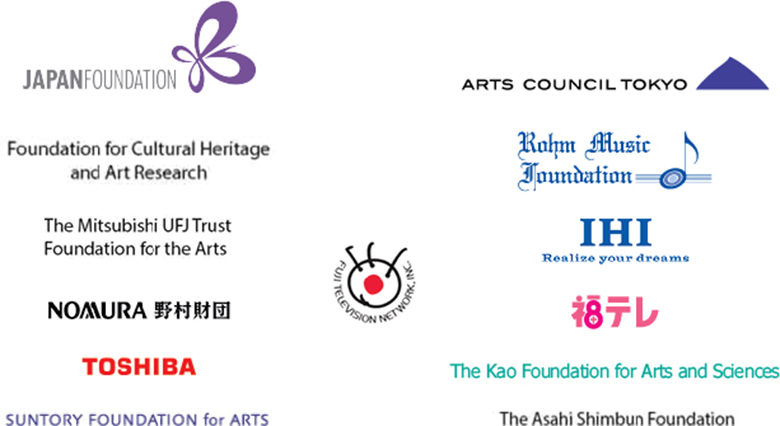

all slideshow photos by Ken Howard
Festival 2022 New York
Saturday, March 5: Current Sounds Japan II
Sunday, March 6: Tomojiro Ikenouchi: His Music & Legacy
Music From Japan Festival 2022 Program
The two concerts comprising Music From Japan’s 47th Anniversary Season, Seventh Artist Residency, and Festival 2022 New York coalesced into a dynamic pairing of the work of three contemporary Japanese composers with that of Tomojiro Ikenouchi and some of his distinguished pupils. The first concert, “Current Sounds Japan II”, took place on Saturday, March 5, and featured recent and newly commissioned works by Yasutaki Inamori, Akiko Ushijima, and Hirofumi Mogi – all of which were either US or World Premieres. The composers drew upon influences ranging from 16th century madrigals to electro-acoustic sound design to the sci-fi writings of Phillip K. Dick to create engaging, deeply personal, work. The pieces were performed admirably by fourteen of New York’s finest contemporary instrumentalists. The second concert, “Tomojiro Ikenouchi: His Music & Legacy”, focused on this central figure in 20th century Japanese music and included pieces by some of his well-known pupils – Toshiro Mayuzumi, Michio Mamiya, and Sadao Bekku. The evening was made particularly moving by the involvement of featured performer and Ikenouchi’s granddaughter, Dr. Kristina Reiko Cooper (cello). Dr. Cooper gave a heartfelt introductory talk on her grandfather and his work before performing, along with John Novacek (piano) and Zac Zinger (shakuhachi), a riveting program of duo and solo works by the aforementioned heroes of Japanese music. Both concerts concluded with a Q&A session, where eminent musical professionals and lay concert goers alike were able to engage in dialogue with the composers (Sat) or the performers (Sun) regarding this beautiful music.
Current Sounds Japan II
On March 5th, “Current Sounds Japan II” commenced the festival with a program featuring pieces by Hirofumi Mogi, Akiko Ushijima and Yasutaki Inamori – each composer chose a piece from their portfolio to present along with one new work, commissioned by MFJ for this concert.
The first piece on the program was Inamori’s Scapula, written for a trio of violin, bass clarinet and piano. Taking its name from another name for the shoulder-blade, the work showcases Inamori’s penchant for polyphony and systematic forethought to composing; Scapula relegates each instrument to its own, distinct, register at the onset, imbuing the polyrhythmic interplay with air and clarity. As the music progresses, the distinct voices slowly begin to mingle more with one another, “analogous to the regular stretching which increases flexibility in the body” (in the composer’s own words). The work concludes with total unification of the instrumental voices in long, clustered, tones that provide a final exhale after much rigorous interplay. Inamori’s commissioned work, Of Sundry Nature, was similarly guided by firm compositional structures, this time drawing on Henry Byrd’s madrigal, Is Love a Boy?. Using the structure and syntax of Byrd’s work as a foundation, Inamori replaced particular components of Byrd’s musical language with his own, more contemporary one, thereby drawing interesting parallels between two works separated by centuries.
The second piece on the program was Akiko Ushijima’s Chatoyant, for classical guitar and electronics (in this case, pre-recorded and played back). Ushijima’s interest in modern, popular music and production techniques was evinced beautifully in this work, performed by MFJ stalwart, Oren Fader. Though it employed language outside the typical purview of pop music, Ushijima employed production techniques more associated with dance and electronic music to great effect. Ushijima’s commissioned work, Swish-Swash Rustle, for flute/bass flute, clarinet, cello and percussion, was entirely acoustic, showcasing her command of instrumental writing – utilizing extended techniques and carefully crafted envelopes of sound to create a work similarly meticulous in its sound world to her electro-acoustic work.
Third on the program was Hirofumi Mogi’s Silence and Illusion, an apt composition for this festival of cultural exchange as it set the words of Soseki Natsume (a Japanese writer who wrote in English) to music for piano and soprano. Wonjung Kim (soprano) and Taka Kigawa (piano) carried Mogi’s setting compellingly, conjuring up Soseki’s yearning for an almost visible, not quite reachable, artistic ideal – a perennial theme for many artists and a salient feeling Mogi hoped to convey in the work. Mogi’s commissioned piece, In Memory of Perky Pat, used Philip K. Dick’s story of a similar name as its inspiration. Centered on themes of attachment/resistance as it pertains to growth and adulthood, the work casts the instruments (horn and string quartet) as characters in the story, whose relationships to each other reflect the character development in the story (ultimately moving towards detachment from one another).
Current Sounds Japan II was concluded by a thought provoking Q&A with Mogi, Ushijima and Inamori. Each composer fielded questions from the audience (of lay people and expert scholars alike), reflecting not only on their work but also their compositional and listening practices.
Tomojiro Ikenouchi: His Music & Legacy
The March 6 concert, “Tomojiro Ikenouchi: His Music & Legacy”, focused on this central figure in 20th century Japanese music and included pieces by some of his well-known pupils – Toshiro Mayuzumi, Michio Mamiya, and Sadao Bekku.
The program was opened by Dr. Kristina Reiko Cooper, who in addition to being a world-class cellist is also Tomojiro Ikenouchi’s granddaughter. As such, Cooper’s introductory talk, titled “My Grandfather, NINI”, struck a deeply personal tone, shedding light on Ikenouchi’s views on beauty, composition, pedagogy, and humor.
The first piece on the program one of Ikenouchi’s, titled Ballade on Ancient Japanese Air for piano and cello – performed by John Novacek and Kristina Reiko Cooper. This work was composed (and revised in 1936) for a pivotal concert in the career of Ikenouchi, one that featured his music exclusively at the Hibiya Public Hall in Tokyo, and cemented him as the master fusionist of French and Japanese approaches to composing music. More specifically, Ballade on Ancient Japanese Air combines the typically French, rhapsodic, approach to narrative with a tonal palette that is distinctively Japanese (in this case pentatonic). It is worth noting, however, that it also harkens to the work of such French composers as Debussy who were inspired by the use of pentatonics in Japan.
Next on the program was Toshiro Mayuzumi’s BUNRAKU – composed in 1960 for a concert celebrating the 30th anniversary of the Ohara Art Museum in Kurashiki and dedicated to Mr. Soichiro Ohara. A work for unaccompanied cello, BUNRAKU drew upon traditional Japanese music via explicit emulation of Japanese instruments (in this case inspired by shamisen and vocal narration) . Kristina Reiko Cooper evoked gravitas and measured storytelling in her approach to the piece, emulating the plectrum of the shamisen and moving through the work without fear of silence. The result, again, was a true fusion of cultures articulated in sound.
The third piece on the program, KIO – written in 1980 by Michio Mamiya – was originally inspired by a poem of Kio Kuroda’s. As the second piece composed as a monody dedicated to Kuroda (the first being Genya for violin and piano), KIO was conceived in response to another duo written for Seizan Sakata and the word-famous Yoyo Ma, in which Yoyo was particularly enamored of the sound of shakuhachi and cello together. For this concert, Kristina Reiko Cooper was joined by Zac Zinger on Shakuhachi, to perform the only work on the program that featured a traditional Japanese instrument. Zinger deftly utilized traditional articulation and phrasing in the context outside that of typical shakuhachi repertoire, and Cooper adjusted equally to situate her cello in this unorthodox duo.
After a brief intermission, John Novacek returned to the stage to perform another work of Ikenouchi’s from 1954, titled Sonatine No. 1. Originally written at the request of pianist Kazuko Yasukawa, this piece showcases Ikenouchi’s dazzling command of French compositional techniques – manipulating, in this case, the developmental characteristics of various conventions – in service of a deeply personal result. Novacek’s touch on the dark-sounding Steinway at Victor Borge Hall was perfectly attuned to the demands of the piece, which he hopes to play on future recitals.
Finally, Cooper joined Novacek for Sadao Bekkus’ Sonate from 1974. Based on a melody the composer had been mulling over for some time, Sonate applies a polyphonic approach to the music while avoiding the typical harmonic movement one might associate with it. As its genesis might suggest, the focus is on the singable melodies sounded by both the piano and the cello. The rapport between Cooper and Novacek was also salient to this performance – the two artists. have been working together for many years
After the concert, the three performers (Cooper, Novacek and Zinger) graciously engaged in a Q&A with the audience. Each artist fielded questions about various topics, including the concert’s repertoire, cultural symbols within music drawing from more than one tradition (such as the work of Ikenouchi and his pupils), and the work of other students of Ikenouchi who were not selected to be featured on this program.
Music From Japan also presented a similar program in a single event in Tokyo, on May 29th, 2022.

Music From Japan Festival 2021
Saturday, March 6 at 7:00pm: The Works of Tomoko Hojo, Click here to stream
Sunday, March 7 at 5:30pm: The Works of Kazuya Ishigami, Click here to stream
Music From Japan Festival 2021 Program
Music From Japan Festival 2021 Brochure
Music From Japan Festival 2021 will introduce a radical new format for MFJ. Interdisciplinary artists Tomoko Hojo and Kazuya Ishigami will bring a weekend of performances coupled with sound installations and multi-channel electronic compositions. The Works of Tomoko Hojo will feature four performances of work composed in the past three years, including two new works commissioned by MFJ. The unconventional, interdisciplinary presentations engage the space through movement, audio feedback, and installation. The Works of Kazuya Ishigami includes five works, with three world premieres of new pieces commissioned by MFJ. These are for electronics and alto saxophone, bass clarinet and shakuhachi, and will be performed by renowned performer/composer Ned Rothenberg. Two older pieces pre-recorded for the festival by the composer, will also be streamed .
Due to COVID-19, all performances will be free and live streamed from Scandinavia House in Manhattan. There will unfortunately be no in-person audience this year.
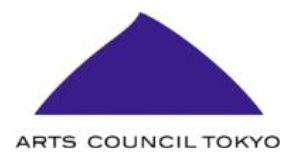



![]()

![]()
![]()
![]()

 .
. ![]()

 .
. 

All photos by Ken Howard
The 45th Anniversary Season
Festival 2020 New York, Fifth Artist Residency
February 22nd: The Works of Noriko Koide
February 23rd: Identity, What Does it Matter? New Generations in Japan
Volvo Hall/Scandinavia House
58 Park Avenue at 38th Street
New York, NY 10016
Complete Program and Performer List
For its 45th Anniversary Season, Festival 2020 New York, and Fifth Artist Residency, Music From Japan invited composer Noriko Koide and musicologist Seiji Choki to New York for a series of concerts and educational events.
The Works of Noriko Koide
On February 22nd The Works of Noriko Koide included seven works from this composer’s eclectic oeuvre. The concert opened with Mistoffelees, named after the character in T.S. Elliot’s book Old Possum’s Book of Practical Cats, which became the basis for the popular musical Cats. The piece, for alto saxophone and percussion, is playful both in its instrumentation and the sounds these instruments conjured. The percussionist’s battery of instruments included not just concert percussion, but also kazoo, duck call, and many other small instruments. The sounds that come both from the percussion and the saxophone are very light-hearted, perhaps even cartoonish, but this levity does not detract from the depth of this compelling work. Tik-tik bird, a duo for cello and triangle (the triangle was performed by the composer herself), also calls for the two performers to sing. Equally playful as the prior piece, tik-tik bird recalls the humorous scene of a bird waking up the composer on a Sunday morning. Musically the piece vacillates between a percussive texture on the cello and triangle, and sing-song almost nursery rhyme-like passages in the voice. The finale was a harmonized song between the composer and the cellist, Meaghan Burke.
There is often a duality in Koide’s work between the conventional and the experimental, and Hone (Bone), for alto saxophone and koto is no exception. The performance delicately lilted between noisy textures and whimsical melodies, drawing especially upon the traditional melodic stylings of the koto. Like many of Koide’s pieces, Tipsy Steps for accordion and piano was inspired by something in the real world: in this case the work is supposed to be reminiscent of someone who has drank a little too much alcohol. The performance begins with a highly unconventional approach to both instruments—tapping them in places other than the keyboards to get a percussive sound. From there the piece seems to move from one scene to the next, meandering between different styles and motifs, perhaps like a drunk person might act.
Koide explains that A Holiday for Island Hoppers, for piccolo/toy whistle and koto was inspired by a lake designed by Japanese architect Junya Ishigami. The lake contains floating islands, and this short piece calls to mind the visitors playfully leaping from one island to the next across the body of water. The two final pieces on the program are part of Koide’s Treasure Ship Suite, which includes seven pieces corresponding to the Seven Gods of Fortune. Yebisu, for flute, violin, viola, cello, clarinet, and piano with conductor, is characterized by light-hearted melodies superimposed on, or punctuated by, percussive textures in the strings and piano. The music finally dissipated into airy and pizzicato sounds before a diminuendo into silence. Bishamon, for flute, percussion, clarinet, baritone saxophone and accordion, with conductor, was commissioned by Music From Japan. The performance for the festival was its world premiere. Perhaps the most dynamic piece on the program, Bishamon features large chordal stops in the wind instruments, with snare drum flourishes reminiscent of a drumline. As the piece progresses, the dynamics decrease as does the density of the chords. The wind instruments, which began by playing long tones, transition into percussive sounds. One unusual element in the piece is the use of hand trowels, which are suspended on cymbal stands in front of the performers. At the beginning, the performers rattle them, and at the end, they slowly walk off the stage carrying them as they rattle, leaving the percussionist alone on stage repeatedly playing rolls on the hi-hat.
Overall, the concert was a fabulous display of this interesting composer’s work. While each composition stood out on its own merits, there was a clear creative voice that permeated them all.
Following the concert there was an edifying forum, moderated by composer Brad Garton, including Noriko Koide, percussionist Sam Budish, and composers Takeo Hoshiya and Yu Kuwabara whose pieces were presented on the Sunday concert. After a warm introduction from Professor Garton, all of the panelists had an opportunity to reflect on the concert and speak about what was to come on the following day. The audience also had the opportunity to ask questions to the panelists.
Identity, what does it matter? New Generations in Japan
Seiji Choki, who curated the second night of the festival, opened the evening with an enlightening lecture on the history of the relationship of Japanese composers to Japanese identity. He separated the past century into five periods, identifying unique characteristics of each, and how composers redefined their relationship to European classical music throughout. Interesting musical examples from Toru Takemitsu, Minoru Miki, Misato Mochizuki and others were offered throughout the lecture. At the end of the talk he discussed the influence of sub-culture, pop culture, and internet culture on present-day Japanese composers. The presentation offered an apt introduction to the sounds that followed.
The concert began with a string trio by Yu Kuwabara called Three Voices, which is built around a series of downward glissandi, unfolding like a series of sighs. Oren Fader, who has been a fixture on MFJ concerts for years, performed the second piece, color song III for guitar solo, by Tomoko Fukui. He gave an introduction to the piece, describing Fukui’s idiosyncratic use of the guitar slide. Like the prior piece, this work also involves a series of glissandos, but rather than a gentle sigh, the music ricochets all over the range of the instrument in upwards and downwards percussive motion. Music for Four String Instruments by Takeo Hoshiya was performed by the Momenta String Quartet. Opting for more traditional string textures, single notes seemed to bounce around from player to player. A second string quartet, this one by Chiku Komiya, called For Formalistic Formal (SONATA?) Form For Four, followed. This strange-titled work relies on an equally strange conceit: the string players only play open strings for the duration of the piece. Relying only on this limited pitch material, based around fifths, Komiya keeps the audience engaged through elaborate rhythmic variations. Into the Offing for flute, clarinet, violin, cello and piano by Yuka Shibuya pensively moves forward through a series of glissandi, punctuated by chords within the piano and clarinet flourishes. Fred Sherry beautifully led the ensemble, conducting this piece as well as two others on Saturday. The music ebbs and flows, undulating in a series of waves. The final piece of the festival was Gewurzwolfie?! for string quartet by Jummei Suzuki. The composition is based off of a work by Mozart, using the canonical work as raw material to modify and transform throughout.
The 45th Anniversary Festival ended with an interesting forum moderated by critic John Rockwell, with curator Seiji Choki, composers Chiku Komiya and Yuka Shibuya, and music writer Michael Huebner. The discussions covered many topics including the increase in women composers in Japan, the role of gender, and the role of Japanese culture in the music presented.

All photos to the right by Ken Howard
Festival 2019
44th Season
Fourth Artist Residency
March 2nd, 7:30pm: Japanese Composers Influenced by John Cage
March 3rd, 5:30pm: The Works of Yumi Saiki
Victor Borge Hall/Scandinavia House
58 Park Avenue at 38th Street
New York, NY 10016
March 2nd
For its Festival 2019, the Fourth Artist Residency, Music From Japan invited composer Yumi Saiki and musicologist Miyuki Shiraishi for a series of concerts and other educational events in New York City. To begin the festival, professor Shiraishi, who curated the March 2nd program, delivered a lecture titled John Cage in Japan: Shock and Afterwords. She traced the reception of Cage and of his music in Japan, from his first visit in 1952 until he won the Kyoto Prize in 1989, and beyond.
The Shirarishi-curated concert Japanese Composers Influenced by John Cage began with Jo Kondo’s piece Dithyramb, a duo for flute and guitar. Oren Fader (guitar) and Elizabeth Brown (flute) brought this playful and melodically refined piece to life. Yoichi Sugiyama’s Smoking Prohibited, a Bay Street Ballad II, New York Version is a piece for alto saxophone composed in honor of Eric Garner. In this world premiere, performed by Ryan Muncy, the microtones, wide vibrato, and rubato feeling of the piece lent it a lyrical and contemplative quality. Why You Scratch Me, Not Slap? is an unconventional piece for guitar written by Tomomi Adachi and was performed by Oren Fader. Rather than a written score, the performer is only provided with a video of hand motions. The guitarist must watch the video and perform the hand motions in real time on the guitar, which is placed on a table. The video is also projected for the audience to see.
The piece following the intermission was by far the quietest and most minimal work on the program: Takahiro Kuroda’s string quartet Let’s also be careful about small thing, performed by Momenta Quartet. The piece consisted of alternating moments of sound and silence of approximately the same duration, with the sound gradually, barely perceptibly changing over time. The performance of the Kuroda piece, commissioned by Music From Japan, was a world premiere. Time Sequence by Toshi Ichiyanagi, performed by Vicky Chow, was the oldest piece on the program, and stood out among the pieces because of its very repetitious and overt usage of pulse and meter. Akiko Yamane chose to have two of her pieces performed at once on the same stage: Dots Collection No. 3 for violin and piano and a vibrating sphere in a room No. 1 for violin. Their contrasting textures complimented each other nicely, with Dots Collection No. 3 insisting on the same plodding rhythm throughout, and a vibrating sphere in a room No. 1 consisting of mostly upper register angular lines.
Following the concert, a panel, moderated by George Lewis, convened. The panel included guitarist Oren Fader, composer David Behrman, musicologist Miyuki Shiraishi, and composer Takahiro Kuroda.
March 3rd
Day two of the Festival, The Works of Yumi Saiki, presented a compelling cross-section of the diverse work of the composer. The insistent pulse of Turn My Mourning into Dancing for flute, clarinet and cello, seemed to echo through the ensemble in various guises, before dissolving into trills and glissandi. In the open forum following the concert, pianist Aaron Wunsch mentioned that when he first saw the score for JOY, a piece for solo piano, he was not overcome with the feeling of joy—that is to say that the piece is very challenging. Yet ultimately joy is precisely what his performance projected: an exuberant feeling, not an effort of technique. Entomophonie II comes from a series of Saiki’s pieces inspired by insect sounds. While the repetitive sounds coming from the quintet of winds and strings were unconventional and dissonant, a calm relaxed feeling presided over the hall, much like actually being surrounded by the plaintive and insistent call of insects in nature. The piece was conducted by renowned cellist and conductor Fred Sherry. Deux Sillages II for violin solo and string trio, is, according to Saiki, a juxtaposition of two types of music, “Asian music on the one hand and Western music on the other.” The result was a flurry of musical ideas and musical movement throughout Momenta Quartet, who artfully interpreted the challenging music. To punctuate each of her phrases, Emilie-Anne Gendron, who performed the solo violin part, kicked a cluster of bells suspended in front of her. Pneuma III (a world premiere and MFJ commission) for flute, cello and piano closed the concert. “Pneuma” means “breath” in Greek but also can take on the metaphorical meaning of “spirit.” The central role of the flutist (in this case Elizabeth Brown), and the use of techniques on the flute that emphasized its breathiness, indeed gave it an airy, effervescent feel.
The weekend concluded with another open forum with Saiki, pianist Aaron Wunsch, composer/writer Matthias Kriesberg, and Ryo Sasaki from Suntory Arts Foundation, moderated by cellist/conductor Fred Sherry. First and foremost, they discussed Saiki’s music, and took questions from the audience. Sharon Nakazato served as the interpreter for the forums on both days.
Apart from the public events, Japan Foundation hosted MFJ’s annual symposium, and Yumi Saiki presented at Columbia University’s weekly composition seminar.
Overall, the week was filled with beautifully interpreted new music by Japanese composers, informative educational programs, conversation, and new connections between composers, musicologists, performers and audience.
© Music From Japan, Inc.

US-Canada-Japan Encounters in Music
Tokyo Concerts Lab
July 5: Classical and Contemporary Gagaku
July 6: Highlights of MFJ Commissions, Tokyo II
Tokyo Final Program
Fukushima City Concert Hall
July 8: Folk Performing Arts of Fukushima
July 9: Iitate Village School
For the MFJ-MCANA institute in Japan, Music From Japan (MFJ) collaborated with the Music Critics Association of North America (MCANA) to bring ten MCANA critics, one US and one Canadian composer to Japan for various concerts and educational events.
Tokyo
On July 5th Classical and Contemporary Gagaku introduced the US and Canadian visitors to gagaku instruments, their use in traditional music, and their subsequent incorporation into contemporary music. Following an informative lecture by Professor Naoko Terauchi, the musicians performed four classical pieces. Afterwards, John Cage’s One9 and Ichiro Nodaira’s Voix Interieur were performed by Mayumi Miyata. Both pieces were originally composed for Ms. Miyata. The 2012 MFJ commission To Be Human for kugo, voice and haisho, by Fuyuhiko Sasaki, followed.
On Friday July 6th, Highlights of MFJ Commissions Tokyo II featured five chamber works MFJ has commissioned over the years. While most of the pieces have been composed in the current decade, a highlight was Shigeaki Saegusa’s Cello ’88 (1988) performed in its Japanese premiere by Tsuyoshi Tsutsumi, for whom it was originally composed.
On the 7th, Tokyo Sinfonietta presented, Music From Japan in Tokyo, a concert at Tokyo Bunka Kaikan Recital Hall, with works by the two visiting composers, Zosha Di Castri and Anthony Cheung, alongside two recent MFJ commissions by Tokuhide Niimi and Naoko Hishinuma, and a work by Julia Wolfe. Di Castri’s piece, Cortege, was inspired by a Cavafy poem interpreted by Leonard Cohen. Cheung’s vis-à-vis was for 18 musicians and live electronics.
Fukushima
After the Tokyo Sinfonietta Concert, MCANA critics, visiting composers and staff of Music From Japan made their way to the train to head to Fukushima. The following day, on the 8th, the group was treated to regional folk performing arts of Fukushima Prefecture at Fukushima City Concert Hall. John Fleming, in his article for Musical America, summed it up well: “A dozen children, ages four to twelve, wearing turquoise kimonos and holding fans or flowered hats, performed graceful choreography to a chanting vocalist, drum, and flute. Three Lions of Kuryusawa featured dancers in gold lion masks. Booming taiko drumming [of Ryozen Taiko] showed how villagers might celebrate the rice harvest.” (Musical America Worldwide, August 7, 2018).
During the visit, the critics and composers also had the chance to meet with Masaaki Suzuki, vice-governor of Fukushima Prefecture. He emphasized that radiation levels are safe in most of Fukushima and that the area is recovering.
The final stop of the MFJ-MCANA institute in Japan was Iitate, a village in Fukushima Prefecture where MFJ’s own Naoyuki Miura’s mother was born and raised. Iitate was almost entirely evacuated after the nuclear disaster. In part due to Mr. Miura’s personal connection to the region, MFJ has commissioned several works that were in some way influenced by the tragic events of March 11th, 2011. One such piece, Time, Come Around (commissioned by MFJ in 2012) was performed on that final day by a students’ choir at Iitate’s newly built school.
Overall, MFJ’s events in Japan offered the invaluable opportunity for ten critics and two composers to travel to Tokyo and Fukushima, meet with their counterparts there, be exposed to both contemporary and traditional Japanese musical culture, and gain a glimpse of the Japanese way of life.
© Music From Japan, Inc.

Festival 2018
New York City at Scandinavia House/Victor Borge Hall
58 Park Avenue, New York (between 37th and 38th Streets)
February 17th, 8pm: The Works of Tokuhide Niimi
February 18th, 5:30pm: Diversification of Japanese Contemporary Music
For the third year of the Artist Residency Program, Music From Japan invited composer Tokuhide Niimi and musicologist Toshie Kakinuma from Japan to participate in a series of educational events and concerts in New York.
The Works of Tokuhide Niimi
Musicologist Toshie Kakinuma gave a compelling lecture called “Trends in Contemporary Music in Japan after the Osaka Expo in 1970,” preceding the concert. In it, she discussed the history of, and shed light on some of the ideological dissonances within, the field of avant-garde composition in Japan after this momentous occasion. The Expo represented a turning point both for the cultural history of Japan and in the life of Professor Kakinuma.
Following the lecture, Momenta Quartet performed Tokuhide Niimi’s String Quartet No. 2 Asura, composed in 2011. The piece began with a pianissimo flurry of notes, that increased in a slow crescendo. Niimi, who seems to have a penchant for bringing life to simple material through his imaginative thematic development, then introduced a four note chromatic descent. That four note theme would reappear in many forms throughout the piece, which was sometimes manic, sometimes brooding. As it came to a close, the chromatic line was inverted into an ascending one, and just as the work began with a tremulous flurry of notes, it seemed to disperse back into the place from which it came, tapering off into nothingness.
The second section of Concerto for Chorus, Bios, followed. Performed by the C4 vocal ensemble, the work opened with a unison that gradually broke off into dissonances. Like the quartet before it, Bios covered a lot of compositional ground, from ponderous chordal stops to tremulous unisons in the upper register. The text, which drew from Kenji Miyazawa, Ralph Waldo Emerson, and a Latin aphorism, were all delivered in their respective languages. Nonetheless, the meaning of the words—which all contemplated the most penetrating questions of life—seemed to be transmitted through the music itself, for all to know and feel.
The final piece, a piano quintet called shape of the soul, was the world premiere of a commission by Music From Japan. While the piece employed some of the atonal elements of the previous two pieces, it also hinted towards a tonal center and heavily used a mode with a prominent augmented second. The use of two double-reeded instruments (oboe and bassoon) emphasized the references to the Middle East, already made apparent by the frequent use of the augmented second.
After the concert, the first panel included Mr. Niimi, Timothy Brown (the conductor of C4 Vocal Ensemble), John Fleming (the current president of the Music Critics Association of North America) and Barbara Jepson (former president of the Music Critics Association of North America), who moderated the panel. The panelists each voiced their impressions of the program, and asked Mr. Niimi questions about his music. The second panel included American composers Anthony Cheung and Julia Wolfe, and Japanese conductor Yasuaki Itakura; John Fleming and Barbara Jepson remained. The panelists discussed MFJ’s upcoming collaboration with MCANA Institute and two American composers, to take place in July in Japan.
Diversification of Japanese Contemporary Music
The second concert of the weekend opened up with two short piano pieces by composer Ryuichi Sakamoto, arranged by Yuji Takahashi. Sakamoto, who is famed for his remarkable adeptness at writing and playing music across many genres, from the avant-garde to the classically elegant, the two pieces that began the program fell into the latter camp. Both River and Grasshoppers, smartly interpreted by Aaron Wunsch on piano, gleamed with clarity and compositional precision, but at the same time did not seem like a repetition of the past, through certain rhythmic eccentricities. Melodia for bass clarinet, by Makiko Nishikaze and performed by Marianne Gythfeldt, followed. Ms. Nishikaze is interested in the spacialization of sound, and somehow, even though the sound was coming from a single performer positioned at the center of the stage, the long tones and staccato notes seemed to emanate from the corners of the room itself. The wa-go-n an ancient koto indigenous to Japan, was the featured instrument in the only traditional piece on the program, Shizuuta, which was transcribed by Mayu Masuda from a manuscript compiled over one thousand years ago. Kayoko Nakagawa performed the piece, which consisted of mostly broken chords complementing the vocal line homophonically. The next piece, shima-zima (Islands), by Makiko Nishikaze did involve an actual spacialization of the sound, with the six performers walking about the auditorium while playing. Like the collection of islands that make up Japan, in shima-zima each performer simultaneously existed as a unique entity and came together to perform as a musical whole. The performance of the piece was the world premiere of a MFJ commission.
After the intermission, Kayoko Nakagawa returned to the stage with the wa-go-n to perform Mayu Masuda’s new work, Narrating Function IV—Rain Rain, another MFJ commission and world premiere. Unlike Shizuuta, the voice and wa-go-n seemed to act more in counterpoint. Dharani, a work for guitar and voice by Yoshihiko Shimizu and performed by Oren Fader was a slow meditation on a single note interspersed with flourishes and microtonal chords on the guitar, and grace notes and glissandi in the voice. The concert closed with HIka Runners High + a playful piece by Noriko Koide. Each of the seven performers also held a music box, with a melody written by Koide. The work, for flute, clarinet, percussion, guitar, piano, and cello, heavily employed chromatic scale runs, glissandi and repetitive machine like rhythms. It was conducted by esteemed Japanese conductor Yasuaki Itakura.
Before the post-concert panel began, there was a demonstration on the wa-go-n. As Mayu Masuda explained different features of the instrument, Kayoko Nakagawa demonstrated, finally performing a short piece. A forum including several of the composers, Stephanie Griffin (Momenta Quartet), John Fleming, and musicologist Toshie Kakinuma, followed.
The Mitsubishi UFJ Trust Foundation for the Arts
![]()

The Asahi Shimbun Foundation
© Music From Japan, Inc.

Festival 2017
New York City at Scandinavia House/Victor Borge Hall
58 Park Avenue, New York (at 37th Street)
February 18th, 8pm: The Works of Kenji Sakai
February 19th, 5:30pm: New Directions in Japanese Contemporary Music
Festival 2017 Program
The Music From Japan Festival 2017 marked the second year of MFJ’s Artist Residency program. This year, we invited composer Kenji Sakai and musicologist Fuyuko Fukunaka to participate in a series of educational events, a symposium and two concerts. Both concerts included pieces commissioned by Music From Japan.
The Works of Kenji Sakai
Musicologist Fuyuko Fukunaka gave an enlightening lecture called Multi-Culturalization in Japanese Contemporary Music: Sources & Politics. The lecture rebuked Western essentialism and orientalism and offered a more nuanced perspective on Japanese identity in music. She focused on several ideas in Western rhetoric about Japanese music, such as ma and stasis, and explained how these are not only insufficient descriptors for modern Japanese music but are also often misleading. Using the story of John Cage’s first visit to Japan as an example, Dr. Fukunaka described the complex relationship between Japanese identity and American projections of it.
The Works of Kenji Sakai began with a virtuosic performance of his Blaze by bassoonist Yen-Chen Wu. The piece was a flurry of arpeggios spanning the entire range of the instrument, interrupted by brief silences and more pointillistic textures employing extended techniques and long tones. Fanfare toward the dusk, an extremely challenging piece for trumpet and piano, followed. The piece seemed based around a single repeated pitch interrupted by sometimes-abrupt transitions and improvisatory flourishes. Borders a world premiere commissioned by Music From Japan, was conducted by the highly esteemed Yasuaki Itakura and featured the shakuhachi player Akikazu Nakamura, both of whom came from Japan for the performance. Finally, Mixtures, performed by the wind quintet Windscape, closed out the concert. The piece was beautifully executed by Windscape, and alternated between sustained chordal sections and more contrapuntal gestural moments.
After the concert, music critic John Rockwell moderated a panel with Mr. Sakai, Yasuaki Itakura, Akikazu Nakamura, American composer Ned Rothenberg, and publisher Masaya Takagi. The Japanese members of the panel discussed how they understood their own identities and relationship to Japanese culture, and Ned Rothenberg and Mr. Sakai discussed microtonalism and the use of shakuhachi among Western instruments. Before the evening was done, several questions were taken from the audience.
New Directions in Japanese Contemporary Music
New Directions in Japanese Contemporary Music, curated by Fuyuko Fukunaka, featured the work of several Japanese composers, with a special focus on those born after 1975. The evening showcased three American premieres as well as the world premieres of two new pieces commissioned by MFJ.
The concert began with Pergola by Jo Kondo—the oldest piece by far on the program. As Dr. Fukunaka explained during the post-concert panel, the piece served as a sort of stylistic and historical point of departure for the pieces that followed. Shoichi Yabuta’s string quartet Edge came next. The piece consisted of several recurring themes—accelerating dissonant chords, dense counterpoint, and passages involving furiously executed scratch tones and other extended techniques. All of this was artfully interpreted by the fantastic Momenta Quartet. Next, Tetsuya Yamamoto’s Crossroads / Y Intersection had complex stage directions with both performers wandering about the stage while performing. The performance culminated in a full blackout of the stage. Shohei Amimori’s piece Love/27/10F began with all of the performers making a “shhh” sound in various rhythms before each eventually turned to performing on their instruments. Like Borders on the previous night, Maestro Itakura conducted the piece.
After intermission, the audience returned to hear Yuta Bandoh’s Seesaw. The piece called for preparations on the piano sonically reminiscent of John Cage’s work for the instrument. After Seesaw, Miya Masaoka (21 string koto), Akikazu Nakamura (shakuhachi), and Brad Garton (electronics) took the stage for an improvisation. Masaoka began the piece with a staccato texture almost like the dripping of water. When Garton and Nakamura entered, the audience was soon immersed in a lush soundscape. The program closed with Yoshiaki Onishi’s string trio, Envoi II. The trio sounded almost machine like, with scratchy and percussive tones repeated in an ever evolving, but repetitive rhythmic pattern.
After the concert, there was an open panel led by Brad Garton with the commissioned composers, Miya Masaoka, curator Fuyuko Fukunaka, and the eminent critic John Rockwell. The main topic discussed was each composer’s relationship to their Japanese identity and how it influenced his or her music. While there were subtle differences in each artist’s answer, the prevalent sentiment was that Japanese identity was relatively low on the list of things that influenced their music, considering the globalized world we live in today.
© Music From Japan, Inc.

FESTIVAL 2016
New York City at Scandinavia House
February 27th: The Works of Misato Mochizuki
February 28th: Japanese Composers in the 21st Century
Music From Japan Festival 2016 Program
The Works of Misato Mochizuki
Saturday, February 27th
Before the concert began, musicologist Dr. Yuji Numano gave a lecture on the history of Western classical music in Japan, and in particular, how identity has informed the growing repertoire by Japanese composers working in the Western idiom. He opened by discussing the Meiji Restoration, when, in 1868, for the first time in two hundred years, Western music, culture, and goods were allowed to flow into the country without restriction. Less than half a century after the introduction of this new music, Japanese composers struggled with the question: how do we compose using Western instruments and Western harmony, but still express our quintessentially Japanese identity through music? Over the course of the following century, composers found various solutions to this tension, yet each had its problems. Dr. Numano concluded that only recently have Japanese composers synthesized something truly and uniquely Japanese in contemporary classical music, while at the same time avoiding the pitfalls of orientalism.
“The Works of Misato Mochizuki” opened up with three pieces from her “Intermezzi” series. The series, inspired by Roland Barthes’ fragmented discourse, is a collection of pieces without a preconceived form. Instead, the form is defined as the piece unfolds, much like Barthes’ style of argumentation. In Intermezzi I, Margaret Kampmeier excited the strings of the piano with various implements, including a piece of a bicycle tube. The piece also called for the flutist, Elizabeth Brown, to play directly into the piano at times, so that the sounds of the flute would resonate through the piano’s strings when the pedal was depressed. In Intermezzi II, for solo koto, Ms. Mochizuki sought to use the koto in ways that were not immediately evocative of the instrument’s history in Japanese traditional music. At first the strings were dampened by a cloth, to deprive the koto of its characteristic resonance. As the piece progressed, the cloth was removed, but soon enough, other extended techniques were used—the strings were scraped by the finger picks, and finally, in the finale of the piece, a ruler was run across the strings. Intermezzi V featured an unusual combination of instruments—accordion and viola. The opening of the piece featured the viola alone, in a kind of morphing ostinato, which included pitches spanning most of the viola’s large range. The use of the accordion was highly non-idiomatic—piercing high notes and the clicking of keys brought the instrument far out of its traditional role as a folk instrument. Finally, Le pas d’apres, which was commissioned by MFJ in 2002 for the Festival 2003, was performed. A trio of flute, guitar, and violin, the piece was percussive in nature. Tapping on the guitar coupled with col legno battuto (a technique that involves striking the strings with the wooden part of the bow) on the violin and accented staccato notes on the flute resulted in a highly pointillist texture.
After the concert, composers Misato Mochizuki and Richard Teitelbaum spoke on a panel with critics Donald Rosenberg, Ken Smith, and Richard Ginell. Mr. Rosenberg moderated the forum. The discussion was mostly about Ms. Mochizuki’s music, her relationship to her own Japanese heritage, her compositional process, and especially the role of the program note and being able to describe and defend one’s work in general.
Japanese Composers in the 21st Century
Sunday, February 28th
The Sunday concert featured eight compositions by eight different composers, all written in the 21st Century. Each one of the performances was an American premiere, except for New York Dance by Hiroyuki Yamamoto and commissioned by Music From Japan, which was a world premiere. Much of the material from Satoshi Minami’s Zigzag Bach is quoted from Book I of J.S. Bach’s “Well-tempered Clavier,” Prelude in C, and A Musical Offering. While the references to the pieces were quite clear at first, the material quickly underwent transformations and soon enough only the impression of the older masterpieces remained in the music. Next, Masahiro Miwa’s work Rainbow Machine Koan-001 was a flurry of notes from the piano artfully interpreted by the formidable Stephen Gosling. Myoclony, a work by Haruyuki Suzuki for violin, cello, piano, trumpet, and oboe, was intentionally disruptive in its flow. Throughout the piece Mr. Suzuki introduced both musical and theatrical disruptions in order to surprise the listener. Falling Dance, by Sunao Isaji, was delightfully evocative of Japanese culture while avoiding orientalist clichés. The cellist (Fred Sherry) and the pianist (Stephen Gosling) used their voices while Mr. Sherry made sweeping glissandi all over the range of the instrument. Yoshifumi Tanaka’s piece An Interview with L.B. Interpreted by viola and piano was a kind of transcription of an interview of Luciano Berio by a Japanese scholar. The work is part of Tanaka’s series “The Speech Transplant Project” in which Mr. Tanaka attempts to transcribe speech into instrumental music, despite the challenges inherent in such a method. While all the composers featured in the Sunday concert are Japanese, Dai Fujikura’s Cutting Sky was the only piece that was written for a Japanese traditional instrument. The piece, for koto and viola, found common ground between the instruments through the use of pizzicato. While the content of Akiko Yamane’s music is far from populist or condescending, she finds inspiration in pop culture themes, often regarded as naïve by the art music world. In this vein, her piece Ambiguous garnet colored fragments was based on her husband Motoharu Kawashima’s dance music piece A Paris. Finally, Hiroyuki Yamamoto’s piece New York Dance was performed. Unlike much contemporary music, New York Dance had a strong implied pulse, with thunderous accents and clusters alternating between the instruments.
The forum following the concert included composers Hiroyuki Yamamoto and Haruyuki Suzuki, critic Nancy Malitz, and musicologist Yuji Numano. Carl Stone moderated the panel, and Sharon Nakazato interpreted. The forum began with comments about the preceding concert and how the composers related to the concepts of “Neo-Japonism” that Yuji Numano introduced in his lecture the day before. Afterwards, Nancy Malitz summarized a symposium that included MFJ and members of the Music Critics Association of North America that happened the preceding Friday, on February 26th. In particular she spoke about a new project that the Music Critics Association of North America has been developing and maintaining: a website called Classical Voice North America. Ms. Malitz explained that Classical Voice North America aims to “provide some of the support structure that was lost when print publications began their long decline” including, but not limited to, editorial support, design and layout, the gathering of photos and multimedia, and marketing. After the panel discussions, the conversation was opened up to the audience in a brief question and answer session.
Overall, MFJ’s Festival 2016 facilitated an incredible amount of dialogue, both verbal and musical, between musicians, critics, and scholars from Japan and the US. Composers and critics alike were given a voice in several different forums to share ideas, share work, and attempt to look towards the future of contemporary classical music.
© Music From Japan, Inc.
